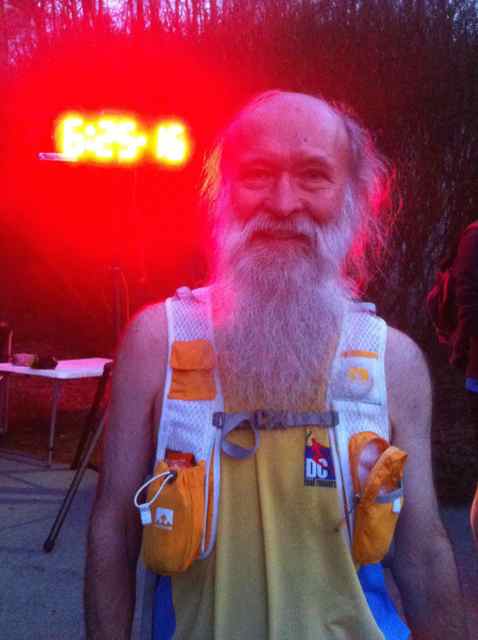

Howdy, pilgrim! No ads — you're in volume 0.9910 of the ^zhurnal (that's Russian for "journal") — see ZhurnalyWiki for a Wiki edition of individual items; see Zhurnal and Zhurnaly for quick clues as to what this is all about; see Random for a random page. Briefly, this is the diary of ^z = Mark Zimmermann ... previous volume = 0.9909 ... complete list at bottom of page ... send comments & suggestions to "z (at) his (dot) com" ... click on a title link to go to that item in the ZhurnalyWiki where you can edit or comment on it ... RSS
 | At 6:25am, as the day begins to dawn, the finish line clock glows cheerfully at the 22nd Bull Run Run. It's five minutes until the start. |
| Today is my seventh BRR, and although the weather is warm overall conditions are good. Runners in the initial spread-out-the-field loop cruise past a pond near Hemlock Overlook nature center, tiptoeing gingerly to avoid wet feet during the first mile. | 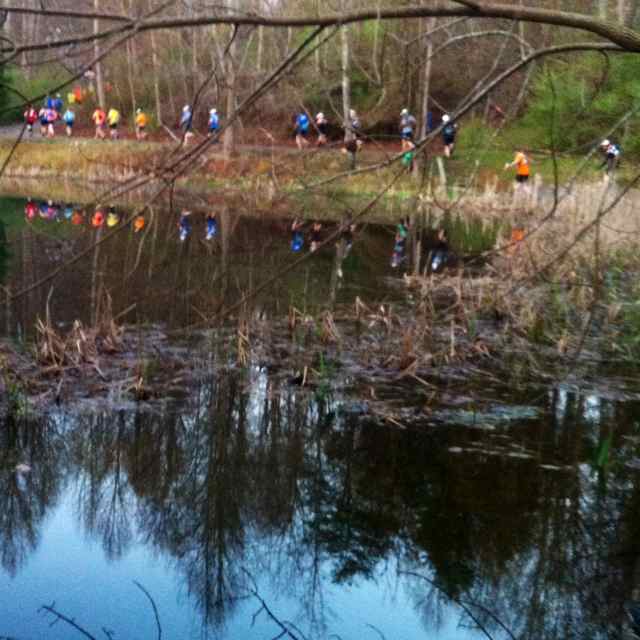 |
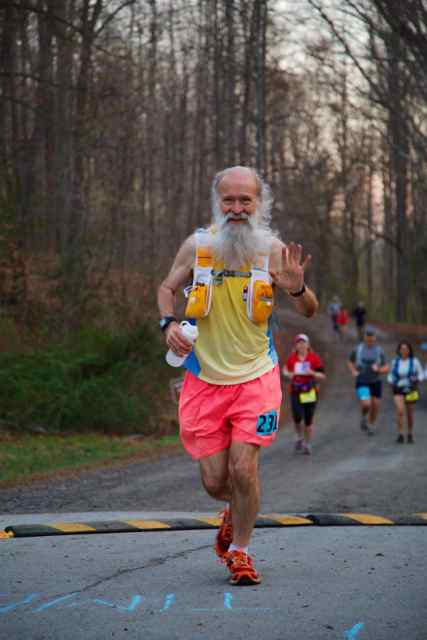 | At mile 1 we return to the start, and it's already time to joke about stopping. Gayatri Datta (visible in the background) and Barry Smith are trying their first BRR. (Photo by James Williams.) |
| Water levels are low but shores are still muddy from recent rains at the steam crossings. This one is Little Rocky Run, about 4 miles into the race. (Photo by Mike Bur.) | 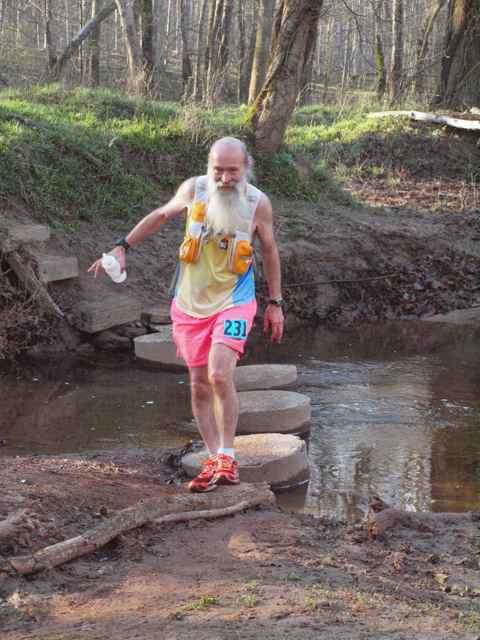 |
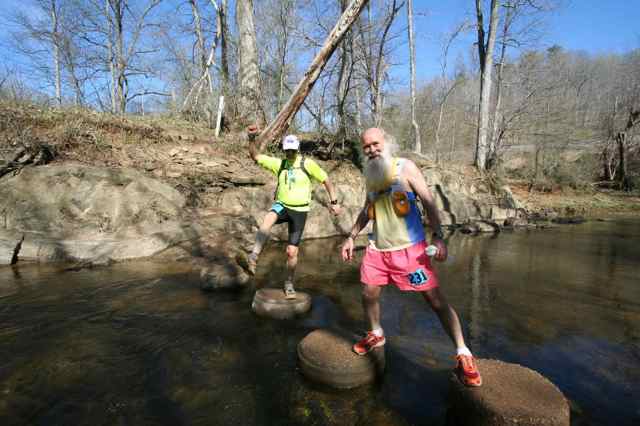 | Bob Fabia photographs Barry Smith and me mugging for the camera at mile ~15, crossing Popes Head Creek on the way back toward the start-finish area. |
| At mile 16 the BRR course returns to Hemlock Overlook where runners can refuel and rethink their race plans. After a leisurely time eating and talking with aid station volunteers I head out, posing for photos. This is where friends Stephanie Fonda and Marshall Porterfield get far ahead of me, with their superior aid station discipline (and superior speed as runners!). | 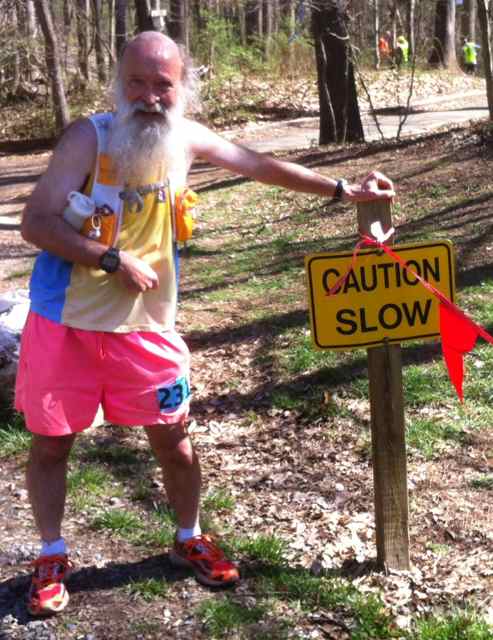 |
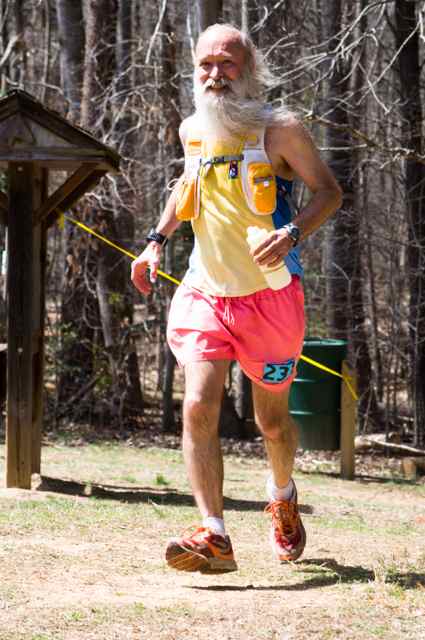 | Hai Nguyen takes one of the best photos of me today at mile ~26, coming into the Fountainhead aid station, when momentarily both feet appear to be off the ground and there's the illusion of actually running. |
| Near mile 32, in the middle of the "Do Loop", an abandoned car is decorated with a Hello Kitty balloon, a topless mannequin, and other bizarrities. At this point, and for most of the previous 16 miles, I'm running alone, pausing to take occasional selfies. Comrade Ken Swab has been far ahead of me almost all day, but the heat has gotten to him and I catch up a few miles later at the return to Fountainhead. Tough Ken goes on to finish the race, however, in spite of nausea and other stress. | 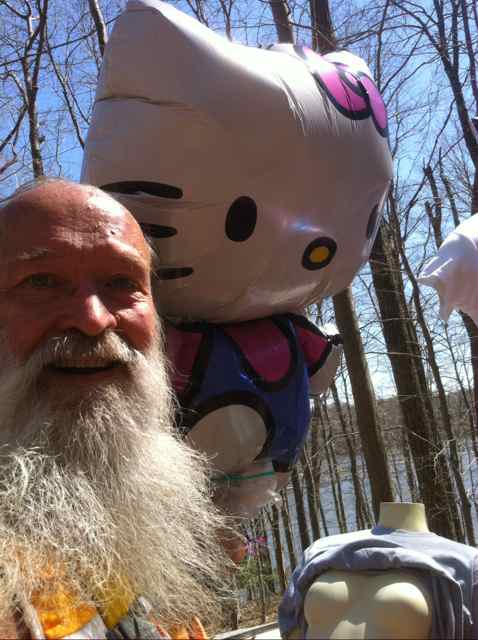 |
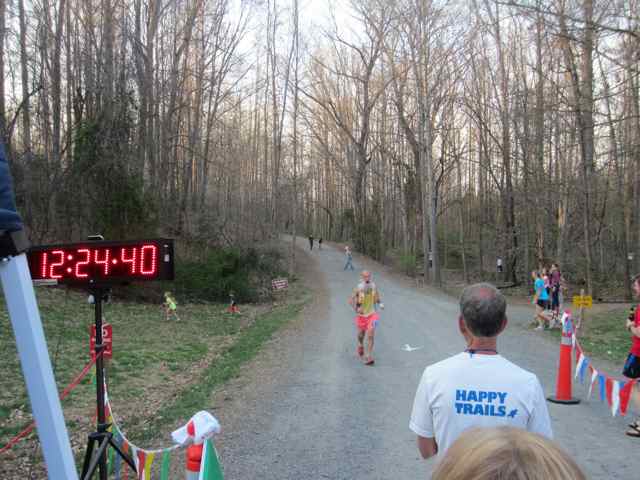 | Approaching the finish line, it's a good time to (attempt to) sprint and show some spirit. Official time is 12:24:45, the median of my 7 BRR finishes. In the last few miles I catch up with Barry Smith, who took a wrong turn, missed a chunk of the course, and therefore honorably withdrew from the race. (Photo by Diane Behm.) |
| Horrible posture, shaking hands with one of the race officials immediately after finishing, but perhaps I'm just coming up from bowing to him? Overall I'm in 238th place of 276 finishers.(Photo by Diane Behm.) | 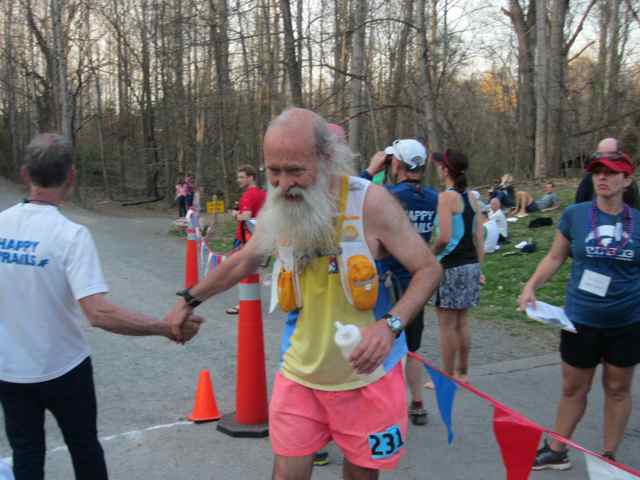 |
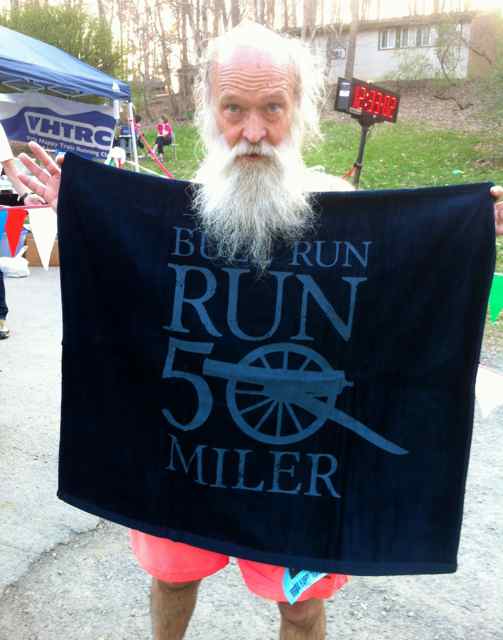 | The Quote of the Day is by 22-time Bull Run Run finisher Tom Green, when I catch up with him about halfway through the race: "Mark! Whenever I see you, I know I'm having a bad day! |
The Garmin GPS shows details of pace, elevation, and course. As usual, it estimates total BRR distance as ~45 miles.
(cf. Bull Run Run 2007, Bull Run Run 2008, 2009-04-18 - Bull Run Run, 2010-04-10 - Bull Run Run, 2011-04-09 - Bull Run Run, 2013-04-13 - Bull Run Run 2013, ...)
- Saturday, May 24, 2014 at 04:57:00 (EDT)
| Pluck poems and make a bouquet Any arrangement of blossoms Sings a hymn in the language of flowers. |
- Thursday, May 22, 2014 at 04:02:36 (EDT)
When an author's name is followed by an advanced degree — "Robert Chuckrow, Ph.D." in this case — perhaps that's a danger sign? The Tai Chi Book: Refining and Enjoying a Lifetime of Practice (1998) waves that red flag, and a number of others. Chuckrow's credentials as an experimental physicist and high school physics teacher aren't particularly relevant to T'ai Chi. His physiological beliefs, particularly as described in Chapter 9 on "Health, Healing, and Sexuality", are astoundingly unsupported by evidence; the discussion of "Taoist Sexual Practices" is unscientific and bizarre by rational standards. His prose is first-person anecdotal, embarrassingly so at times.
And yet, there are also insightful moments, as in the discussion in Chapter 8 ("On Being a Student") about "Practice in Everyday Life":
Professor Cheng used to say that mere practice of the form is superfluous when everything a practitioner does is in accordance with the principles of T'ai Chi Ch'uan. As a result of these words, early on in my study of T'ai Chi Ch'uan, I became inspired to infuse every action in my daily life with the T'ai Chi Ch'uan principles.
For example, when I drove my car, I practiced holding the steering wheel so lightly that I could feel the effect of every change in the road surface. ...
I used opportunities, such as standing on a check-out line in a store, to root by standing on one leg while relaxing the upper body. I also practiced walking in such a manner that I did not commit my weight to a foot before feeling the ground underneath. ...
Overall, though, the mix of mysticism and muddle, the general disorganization, and the lack of critical analysis make it hard to read and learn from The Tai Chi Book.
(cf. Robert Chuckrow's web site, ...)
- Wednesday, May 21, 2014 at 04:51:00 (EDT)
How many helpful interactions can a person have every day? Unless in the wilderness, generally hundreds, maybe more — smiling at a store clerk, sharing a bit of useful information, letting another car merge smoothly onto the freeway, picking up a dropped handkerchief, etc. Easy, cheap, fun.
Maybe optimal (maximization of total expectation value of cosmic utility?) would be to work on doing more such little kindnesses, rather than trying to write a best-seller, become a celebrity, win the Big Game, etc. At ~100/day that's a few million per life ... hmmmmm!
(cf. Underappreciated Ideas (1999-07-06), LastGoodDeed (2002-08-09), Franklin's Virtues (2008-05-23), Dusty Graves (2009-10-23), ...)
- Tuesday, May 20, 2014 at 05:04:28 (EDT)
By analogy with "Battle Buddy", US Army fellow soldiers assigned to help colleagues (and reduce suicide in stressful times), how about Buddha Buddy — a spiritual-development friend-pair, each of whom encourages the other in awakening and mindfulness?
As per Samuel Johnson:
The greatest benefit which one friend can confer upon another, is to guard, and excite, and elevate his virtues.
and likewise Robert Nozick's observations:
... the benefit of being helped along by good examples and good companions ... the joy in encountering a like person, in the experience of the other and in the mutual recognition of the mutual joy ... The developed person will want to help perfect others; this is the most important aid he can give them. We want to find a way of living whereby our best energies and talents are poured out so as to speak to and improve the best energies and talents of others. We want to utilize our highest parts and energies in a way that helps others to flourish.
And as my Buddha Buddy suggests, one can shorten that to "Bud-Bud", or maybe just "BB"!
(cf. TAIL (2009-09-26) re "Medics receive battlemind training to help fellow Soldiers", ...)
- Monday, May 19, 2014 at 04:27:07 (EDT)
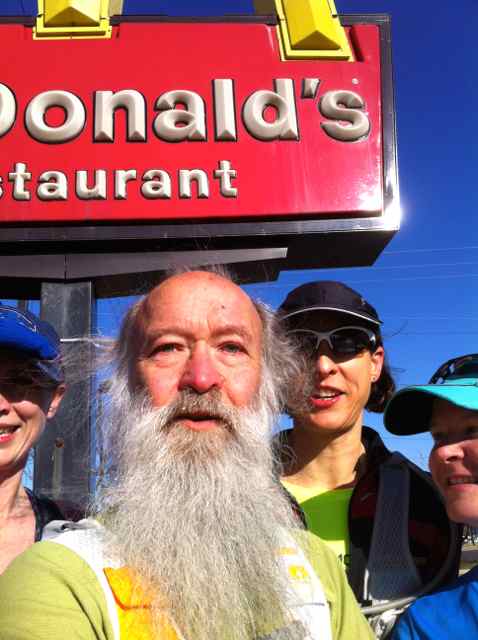 | "I smell carbs!" It's a fun trek around the extended 'hood with Amy Couch & Courtney Jenkins, both preparing for the Gettysburg Marathon at the end of April, and Stephanie Fonda, like me tapering for Bull Run and other upcoming ultras. |
| Weather is near-perfect, just slightly crisp. I lend Dr Fonda my gloves at the start, and then attempt to guilt-trip her by complaining of cold hands. Amy shows us her tattoos. Courtney tells training anecdotes. We discuss Game of Thrones. The gang stops today at three McDonalds, one of which gives me free coffee. Do I look that scary? But it turns out that there's a promotion underway to compete with Taco Bell for breakfast traffic. As usual, "free" tastes great! |  |
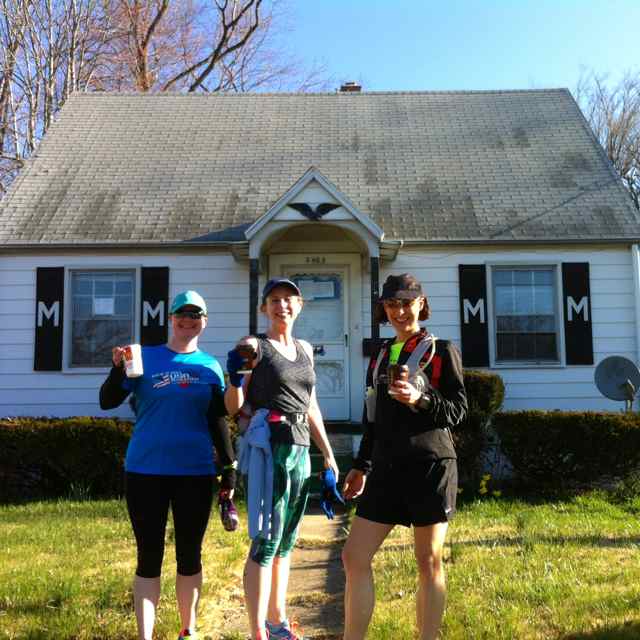 | On Randolph Rd we pause to pose in front of a house with "M" designs on the shutters, and to show off the drinks we're carrying. Conversation turns to straw curls and French braids. |
| Farther down Randolph Rd there's a mini-shrine, perhaps an impromptu memorial to victims of a traffic accident? |  |
 | Approaching Wheaton Regional Park geese attack, or at least attempt to. Stephanie admits to throwing up once the previous day — 'flu? food poisoning? |
| An unopened bottle of Ouzo lies just outside the NIH fence near mile 15. Courtney and I send Stephanie and Amy ahead for the final five miles, to spare them my interminable lectures on the history of the DC Boundary Stones, the Georgetown Branch railroad, the Columbia Country Club, etc. Subtract 1 mile at start (for the jog from my home to Amy's) from the trackfiles to get their distance. The Garmin GPS estimates a mile less than the iPhone's Runkeeper, perhaps due in part to mega-glitches at the Wisconsin Av tunnel. We did not run mile 19 in 6:26, alas! | 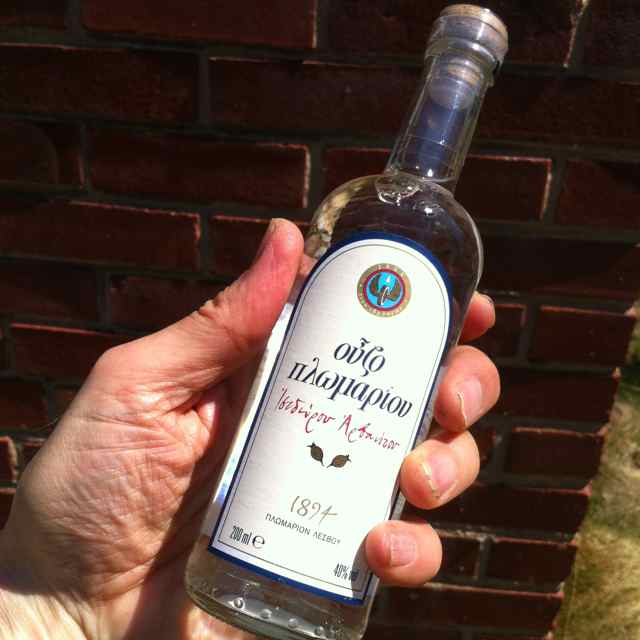 |
- Sunday, May 18, 2014 at 05:40:26 (EDT)
| Like a Godray, Nature points toward the Sun, Where remarks of light began Eight minutes ago And now sprawl Wanton Across the sky. |
- Saturday, May 17, 2014 at 05:19:12 (EDT)
Fireflies drift through the dawn fog over Ray's Meadow — suddenly changing, as I approach, into reflected headlights on a pond in the middle of the ball field. At Candy Cane City Sandra "Sam" Yerkes & Gayatri Datta join me for a trek down Beach Dr into Rock Creek Park, to near Military Rd and back. I leave them at Meadowbrook Stables where they join Barry Smith, and "blast" out a fast-for-me mile #10 along the flat bikepath at 8:57 by the Garmin — then chase a lady in black and her dog up the hill out of the park, divert into the National Park Seminary to circle the lovely Mermaid Fountain, and "sprint" home across the train tracks. Runkeeper and Garmin GPS record details, disagreeing as to total distance by ~3%.
- Friday, May 16, 2014 at 05:16:02 (EDT)
A dear friend, looking for a worthy mate, when challenged to be more quantitative came up with parameters to rate spousal candidates:
Some of these dimensions overlap, some are clearly correlated, and some are more or less important. One could apply numerical weights to each, but that's arguably an unnecessary degree of false precision. They're listed in rough priority order in the friend's current thinking, more valued ones first.
Challenge: define a scale along which to measure each. A simple binary "Yes/No"? Or "Low/Medium/High"? Linear numeric, maybe 1-5 or 0-100?
Perhaps better, an open-ended logarithmic rank, as per ClassyPeople:
It's an open-ended approach, simple and fun to apply. Of course there are only a handful of Class 9+ folk on the planet at any given time in any given category. But isn't that what one wants (or wants to believe one has found) in a soul-mate for eternity?
More to follow, perhaps, on schemes to organize these and other parameters, and ideas for combining their values to produce an overall score.
(cf. ClassyPeople (2000-04-01), CheckMate1 (2001-11-26), CheckMate2 (2001-11-30), ...)
- Thursday, May 15, 2014 at 04:49:50 (EDT)
From an otherwise not-so-memorable book on T'ai Chi, a metaphor: "A master of taijiquan has arms which are as strong as steel rods wrapped in cotton, with immense power conceived therein." (Yang Style Taijiquan, 1988, page 14)
And the Quote of the Day from office T'ai Chi group leader Weider Young, on 20 March 2014: "Emptiness is not really nothing. It's above and beyond, like the third side of a coin. Like in Buddhism, where the Middle Way is not in between. It's above."
(cf. MarvinMinskySpeaks (2004-03-25) re "... Never get into a fight with a pianist. They have terribly powerful arms.")
- Tuesday, May 13, 2014 at 04:51:06 (EDT)
| "Good morning, Honeybunch!" the school crossing guard greets me at dawn. Hmmm — it's dark, but not that dark, during a last-day-of-visit ~10 mile loop around my Mother's neighborhood in northeast Austin TX (see Runtastic GPS for map/pace/elevation). "Hi, Mark!" neighbor and new friend Sharon shouts as I trot by her home on the final stretch. | 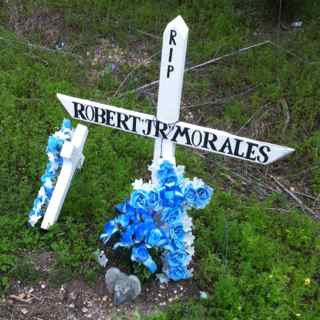 |
 | In between: commuters in their cars line up to cross the highway, narrow shoulders make for scary jogging, four socks (none matching) lie by Decker Rd within a single quarter mile, a huge city power plant glows on Walter E. Long Lake, intermittent sidewalks under construction make for tricky footing by Daffan Lane, and a styrofoam memorial cross with blue plastic flowers stands next to Old Manor Rd to remind one to step aside into the weeds or hug the guard-rail when trucks zoom past. |
| At mile 8 I divert to photograph the X.T.C. sign at a club where my Mom jokes she wants to have her next birthday party. Hmmmm, "Wednesday Night Oil Wrestling" — is that a new Texas petro-magnate sport? |  |
- Monday, May 12, 2014 at 04:50:45 (EDT)
Texas-wide sidewalks, maybe reserving space for future road expansion, aid a fast-for-me urban loop around my Mom's extended neighborhood, passing by a golf course and multiple convenience stores, pawn shops, check-cashing facilities, gas stations, Whataburgers, Sonics, and Taco Bells (I resist temptation to stop for breakfast). Rolling hills and high humidity are countered by intermittent breezes and merciful clouds. Runtastic using the iPhone GPS records the route and estimates the splits.
- Sunday, May 11, 2014 at 06:07:32 (EDT)
During an online debate among colleagues at the office, on how to produce and deliver a complicated software system, memorable wise comments by Frank P:
... Moral of that story? This is all complex systems stuff. You barely know what you know, and there's a lot you don't know, but don't know it. You need to define a "good enough" first step. Wade in and deploy to some "friendlies". Learn what you didn't know, adjust fire, and shoot again. It only takes a couple of iterations to get it right. When new things present, fix them. ...
(cf. WickedWork (1999-09-08), Circle of Concern (2012-07-18), ...)
- Saturday, May 10, 2014 at 05:28:54 (EDT)
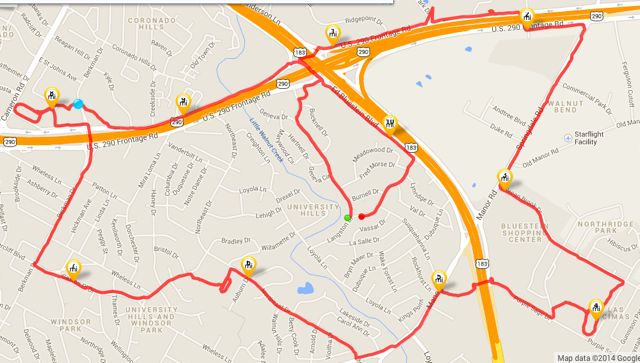 | Visiting Austin Texas: neighborhood ramble includes digressions to photograph a Dr Pepper "TASTESTOSTERONE" billboard, plus single-laps sprints at the LBJ High School track (1:58 at mile ~4), the J. E. Pearce Middle School miniature track (~0:50 at mile ~6), and the J. H. Reagan High School track (1:52 at mile ~8). The iPhone Runtastic GPS records the route. |
- Friday, May 09, 2014 at 04:18:31 (EDT)
A fancy piece of chocolate comes wrapped in foil that offers a fortune/proverb. Yesterday's says:
| Keep the promises you make to yourself. |
Three interpretations:
Fascinatingly ambiguous — deliberately so? And are there other meanings? How about in other choco-"fortunes"?
- Thursday, May 08, 2014 at 04:46:51 (EDT)
Colleague Tony Z last week, sticking his head through the doorway to deliver some news, says, "I'm just doing the Messenger RNA thing!"
- Wednesday, May 07, 2014 at 04:35:25 (EDT)
From the 2014-04-23 lunchtime workshop "Introductory Series on Meditation" (session 1 of 4) by Rob Creekmore:
Quote of the Day:
Topics:
Second half of the session was a guided body-scan, top-down, a meditation focusing on sensations, followed by some sharing of observations by the participants:
Personal Notes & Observations during the second half-hour:
(cf. Meditation Retreat (2014-01-28), ...)
- Tuesday, May 06, 2014 at 04:29:36 (EDT)
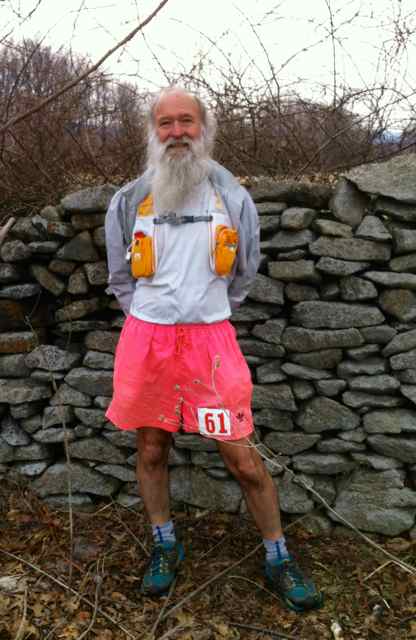 | Ten years after my first ultra — HAT Run 2004 — it's time to return once more, this time with Barry Smith and Gayatri Datta. The course has changed a bit over the years, but the fun factor, including scary stream crossings, remains high. By chance this year bib number equals age. |
| The legendary gnarly tree (an American Beech, Fagus grandifolia) remains as dominating as it did during the HAT Run 2008 when Caren Jew and I paused there to take photos of each other. It's somehow prettier at mile 22 during the second lap than it was at mile 9 the first time around. | 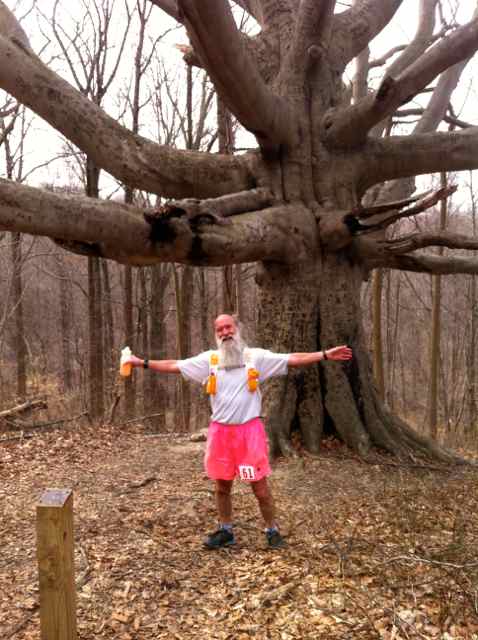 |
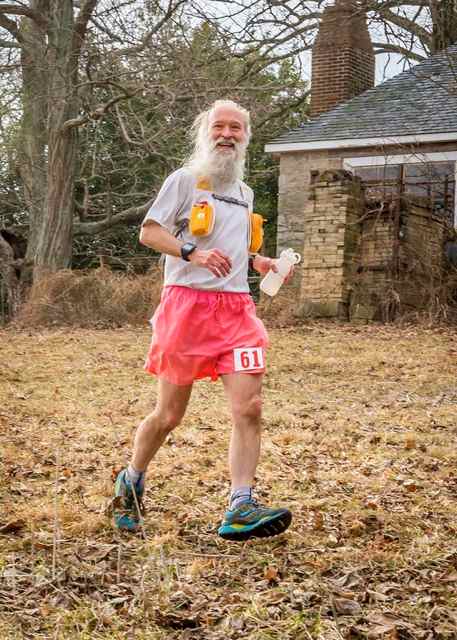 | Photographer Shawn Bowman catches me mid-course apparently running, an unusual moment in a race with über-steep "Capital-H Hills" along with plenty of rocks and roots, plus occasional bogs. It's my sixth HAT — I took a break after the first five to avoid "streaker syndrome" addiction. |
| Diane Behm snaps a shot of typical HAT terrain this year, muddy paths through brown woods. Friends Stephanie Fonda and Marshall Porterfield set a steady pace and finish half an hour ahead of me. | 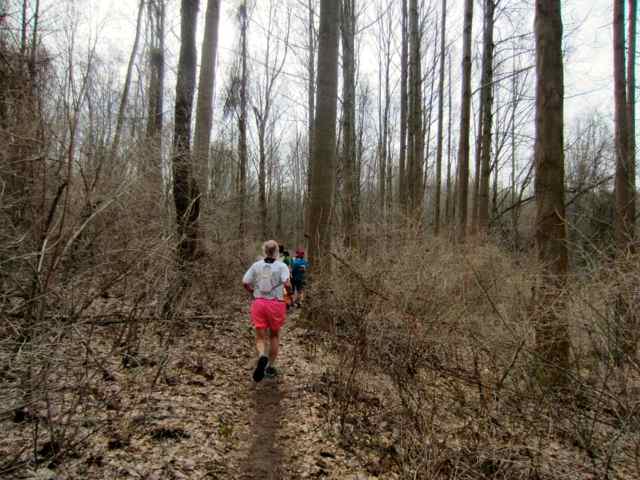 |
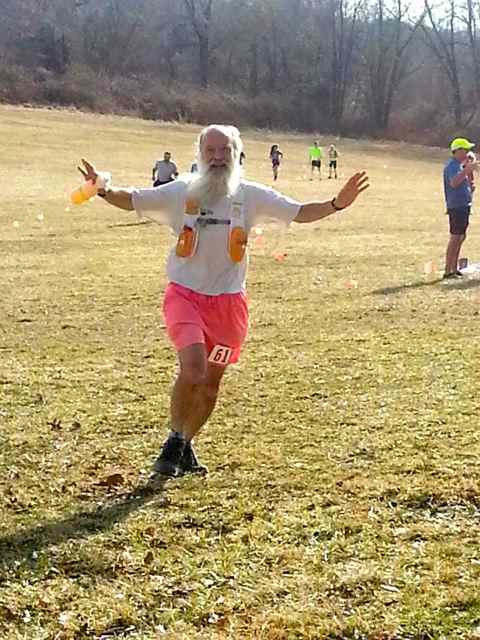 | As the finish line comes into view Shelly Cable catches a joyful moment: 324th out of 383 finishers (plus 50 DNFs) — first lap 3:59:30, total time 7:37:37. At the finish line Phil Anderson, a founder of the race (he's the "A" in "HAT"), shakes hands and poses for photos. |
| Post-race there's veggie jambalaya and fresh hot French fries. Finisher's swag this year includes a big glass and towel, plus of course another HAT hat. Barry comes in a few minutes behind me. Gayatri chases the cutoffs, runs with the sweepers, and pushes to finish with five minutes to spare. Yay! | 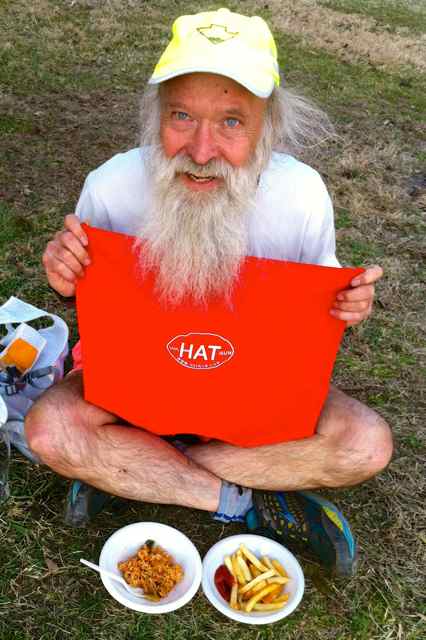 |
The HAT Run Garmin GPS trackfile reckons 29.7 miles, at an average ~15.5 min/mi pace — fastest mile split 10:18 (!) at mile 24 (!!), downhill along a long road segment — slowest 21:20 at mile 22, pausing during the second lap to take more photos of the gnarly tree and fellow runners.
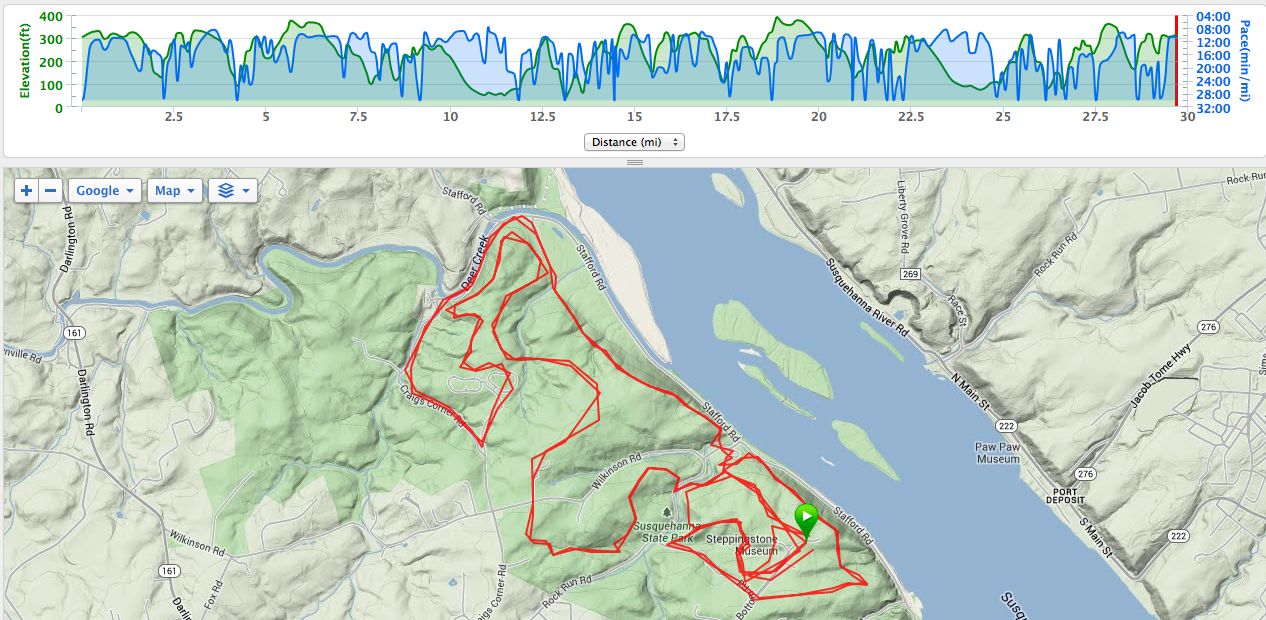
(cf. HAT Run 2004 (2004-04-02), HAT Run 2005 (2005-03-20), HAT Run 2006 (2006-03-31), HAT Run 2007 (2007-03-25), HAT Run 2008 (2008-04-01), ...)
- Sunday, May 04, 2014 at 13:15:59 (EDT)
A few days ago comrade KH and I, in online chat, each began trying to take responsibility for the other's failure in some trivial thing: "I must not have said it clearly", "No, I must be hard of hearing", etc. After a brief exchange I raised the stakes with:
"Don't get into a self-deprecation contest with me — it's my greatest strength!"
... and followed that up immediately with:
"Well, I guess that wasn't a very self-deprecating statement ... hmmm ... looks like I'm no good at self-deprecation either, eh?"
... a hard-to-beat move to a higher level of meta-banter!
- Friday, May 02, 2014 at 04:25:06 (EDT)
Former colleague and friend Les Lilliman sometimes for semi-humorous effect said blower meaning "telephone". Belatedly, from Wikipedia:
... a slang term, especially in the United Kingdom. The slang came from the Royal Naval ships prior to telephones. Communication was direct, through a voice pipe. The pipe had a whistle inserted at each end. When a message was to be passed, the caller would remove the whistle at his end, place his mouth into the cavity, sealing it. He would then blow hard. The whistle at the other end would attract the man on watch. He would remove his whistle and call into the pipe. Conversations over, both whistles were replaced. ...
Words are wonderful!
(cf. IdeaChampions (1999-07-04), ...)
- Thursday, May 01, 2014 at 05:09:08 (EDT)
At a briefing on 2014-04-24, when a colleague said, "Everybody needs to think," senior scientist Rod Holland observed: "You'd be surprised. Some just need to be decisive!"
(cf. John Cleese in Hare Brain, Tortoise Mind (2005-06-03), ...)
- Wednesday, April 30, 2014 at 05:35:34 (EDT)
In mid-2012 Tom Fox of the Washington Post interviewed Getting Things Done coach/writer David Allen. Summarizing that summary "How to clear your inbox, make decisions and generally get things done":
Allen's core psychological advice: "When you most need to plan is when you least feel like you have time to do it. When you're feeling most out of control is when you most need to back the world off and stop, sit down and work on your own process."
(cf. Mind Like Water (2011-12-24), Getting Things Done - Summarized (2012-05-14), Mindless Mind (2012-10-06, ...)
- Tuesday, April 29, 2014 at 05:38:50 (EDT)
The term "Kung fu" doesn't (or perhaps shouldn't) just suggest Chinese martial arts. The original words and usage (according to Wikipedia at the moment) mean semi-literally "achievement of time". That is, it's the result of long-term application of energy, of training body and/or mind in some discipline, of developing skill via practice and work. So a person can "have good kung fu" in cooking or calligraphy.
Hence, the lines in the scientifically-silly film The Core, wherein hacker character "Rat" Finch (played by actor DJ Qualls) chortles, "Your Kung Fu is not strong!" as he breaks through software barriers.
(cf. RatTales (2003-05-10), ...)
- Monday, April 28, 2014 at 05:43:30 (EDT)
From Chapter 18 of There Are No Secrets by Wolfe Lowenthal, thoughts on non-resistance:
Again: the crucial article of faith — the practicality of softness.
The "difficulty" is that softness is a quality of the true self, that which exists beneath our myriad defenses.
Resistance is rooted in our lack of faith in the self. We create armor to protect that self from the world: hard images of strength and brittle, false fronts. These images exact a huge toll of energy required for their maintenance.
Because of this psychic armor, we are blocked from creating or loving, and the awareness that we are living a lie compounds the fear and self-disgust.
The gung fu is to be soft, to let the armor drop, and relax down the gentle, tender self that exists between it.
(cf. Gentleness, Sensitivity, Compassion (2014-03-09), Virtues of Softness (2014-03-20), Good Manners and Taiji (2014-04-03), Taiji and Self Awareness (2014-04-15), ...)
- Friday, April 25, 2014 at 04:26:26 (EDT)
In December 2012 in The New Yorker pianist Jeremy Denk writes a lovely essay in memory of musician-author Charles Rosen (1927-2012). Denk begins:
To visit the pianist and thinker Charles Rosen, you walked down a long corridor lined with bookshelves, past the complete works of famous and obscure writers, past a cabinet containing old French spoons, glassware, strange utensils—true dusty bric-a-brac, the fruits of decades of Parisian browsing. At the end of the corridor was the nerve center: a piano stacked with music, a desk stuffed with papers, a threadbare couch, and a book-covered coffee table. It was desperately unhip. But it was affecting and intense, the accumulation of things, of ideas, and Charles's shuffle. You felt a kind of slow frenzy at his place—connections mounting upon connections, understanding upon understanding. Erosion in reverse.
When I came across the word "discursive" in one of his obituaries, I laughed: Charles was really a spigot of information that could not be shut off by any normal means. My first close encounter was in 2007. It was a dinner that began innocently enough around 7 P.M. Well after midnight, there I was, listening in what I hoped resembled rapt attention while he narrated—for reasons that, even then, I couldn't recall—the plots of several plays by Alan Ayckbourn. My brain had become an achy fuzz. One of the hosts kept trying to get Charles off track by telling filthy Yiddish jokes, which Charles divinely ignored, his expression a mix of pretended confusion and distaste. At some point the other host explained to me that if I wanted to survive, I had to just get up in the middle of a sentence and flee for the hills. This eighty-year-old man was outlasting me. I would sadly have to be rude in order to preserve what was left of my sanity.
And Denk concludes with a splendid metaphor of how science and art work:
The image I have right now is Charles looking over the whole puzzle of culture, all the well-worn, greasy, handled pieces scattered in a million directions, spread over the carpet, unsolvable. He had an unending supply of discoveries and clues and he had faith that if you looked at the pieces properly, their sense and connections would reveal themselves. He would hold up a few pieces at a time, think about them, then go to the next; he was not overwhelmed by the vastness of the puzzle.
- Wednesday, April 23, 2014 at 04:12:55 (EDT)
(Beware: nerdy naughtiness alert!)
Bill Press was a general relativity grad student a few years ahead of me in the Caltech physics department. He went on to become a Harvard professor, a senior Los Alamos scientist, a member of the National Academy of Sciences, a JASON, and the recipient of countless honors. (He was also a friendly and enthusiastic user of my primitive free-text information retrieval software; cf. IndexerBrowserFlashback.) Among the many technical papers that Bill published was his "Mathematical Theory of the Waterbed" in the October 1978 American Journal of Physics.
Independently, a few years later in the early 1980s I was meditating on the shape of fluid-filled membranes and derived some of the equations for simple two-dimensional models assuming that the tension in the surface, proportional to its curvature, is the only force that counteracts the pressure in the liquid, which grows linearly with depth. Then I found Bill's work on the more complex (but less æesthetic) configuration of a water bed. Great and, in my case, not-so-great minds, eh?
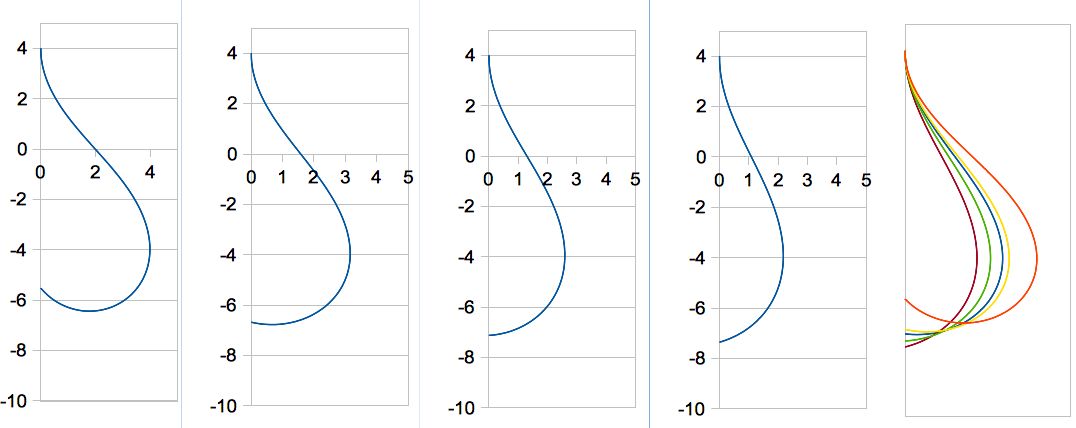 |
By varying parameters, as shown in the diagrams, a line with curvature proportional to Z-coordinate assumes <<blushes>> rather interesting configurations.
Challenge: extend the two-dimensional model to 3-D, and/or add the time dimension to show dynamic bouncy behavior!
(cf. NeedForSpeed (2002-08-10), AwesomeProwess (2003-07-17), BrainyJogbra (2004-05-07), ...)
- Sunday, April 20, 2014 at 11:45:38 (EDT)
Seven years ago Thomas Armour, colleague and friend, passed away of brain cancer. Once upon a time he signed his emails "Armourer" — alluding, perhaps, to his job managing the development of computer tools for better analysis of complex data. He built armor to protect against mental mistakes.
Armour once was a featured speaker at an information technology offsite meeting. Instead of a normal briefing with boring vugraphs, he sat in a chair in the middle of the room and discussed the need for software developers to respect their Users — even, or especially, when the Users don't write code, can't accurately describe their needs, and are scarcely computer-literate. The Users are smart people, trying to do something hard, maybe something that IT weenies don't properly understand. "Talk to them!" Tom said.
Sometimes Armour also called himself "Factotum". It's a great word, and according to today's Wikipedia definition:
A factotum is a general servant or a person having many diverse activities or responsibilities. The word derives from the Latin command (imperative construction) fac totem ("do/make everything").
| Tommy Armour, R.I.P. |
(cf. Speak for the Users (2013-09-24), ...)
- Friday, April 18, 2014 at 04:42:07 (EDT)
Howard Rheingold's 1988 book They Have a Word for It is out of print and has long ago been lost in the chaotic mess of the local environment (if it still is here somewhere), but some of the idiomatic phrases in it remain in memory and occasional household use. One example: "building a bridge", to describe the plausible engineering of a lengthy vacation from a mid-week holiday. The current Wikipedia article on that theme, "Long Weekend", lacks Rheingold's loving description of the creative process. A Thursday holiday only requires slight advance preparation on Wednesday ("I feel a cold coming on ...") to make a Friday call-in-sick seem innocent. To "build a bridge" from a Wednesday (or even Tuesday) holiday to the following weekend, however, takes genuine artistry on preceding days. Master craftsmen who feign illness well enough to overcome the boss's suspicions are, according to Rheingold, called in Italian pontisti, aka bridge-builders.
(cf. Japanese Boyfriend Scale (2009-07-01), ...)
- Wednesday, April 16, 2014 at 04:37:28 (EDT)
From Chapter 7 of There Are No Secrets by Wolfe Lowenthal, thoughts on why to thank a difficult, troublesome person:
... No matter how hard and unyielding our opponent, our inability to gently deal with him is indicative of our own stuckness. It is the exploration and eventual dissolving of the stuckness — not winning — that is the point of push hands. The "game" we really should be playing is with ourselves; we are coming face to face with the physical expression of the issues we hide from in our lives. In this confrontation with the self there lies the possibility of progress. We thank our opponent for providing us with this opportunity. If we really understood K'e Ch'i we would bow to anyone who "pushed our button" rather than become angry.
(cf. Gentleness, Sensitivity, Compassion (2014-03-09), Virtues of Softness (2014-03-20), Good Manners and Taiji (2014-04-03), ...)
- Tuesday, April 15, 2014 at 04:11:59 (EDT)
| Amy Couch's long training run again overachieves, with 25+ instead of her goal distance of 24 miles, plus in this trackfile solo fractions from/to my home at start/end. We trot a bit too fast down 16th St to the Mall, dodging tourists and taking photos of each other at the White House, the Washington Monument, and elsewhere en route, returning via Rhode Island Av and Sligo Creek Trail on part of the route from 2014-02-23 - Sunday Morning Ramble with Amy and Gayatri. We hit the wall at mile ~20 but trek onward to close the loop. My left hamstring feels weak the whole day, and Amy's left knee likewise is twingy. Amy trips and falls about mile 15, in a little park in Mt Ranier MD, the corner of Perry St and RI Av. She stumbles on a ground-inset drain cover that's sticking up — ouch! — and suffers bad scrapes on left knee and both hands. We sit for a minute to evaluate, walk a few blocks, and then start running again. In this image, although apparently flying I'm actually perched on the edge of a fountain at Meridian Park. | 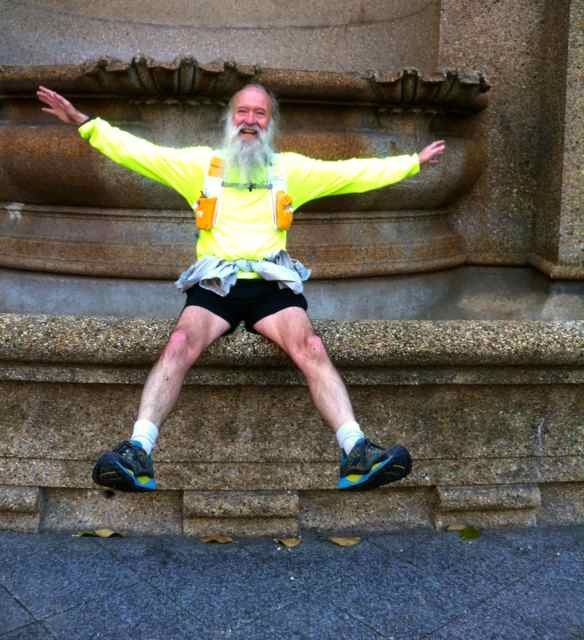 |
 | A young Liz Taylor graces the side of a China Express at the corner of 7th and Q St NW. Statues in front of a restaurant/bar on 16th St depict a line of ladies semi-draped. "They look cold today!" Amy comments with a wink. That leads to further analysis of the gender-asymmetry common to sculptures featuring unclothed females and fully dressed males. The funniest moment of the day happens at mile ~6. I'm holding a water bottle under one arm, trying to help Amy get her cellphone out of a pocket, and inadvertently squeeze down on the bottle, sending a big squirt of water onto her phone and leg in what to a Freudian might look like a rather, uh, male phenomenon. My face is red; Amy laughs. |
Runtastic estimates ~27.5 miles @ ~13.3 min/mi but the Garmin GPS is more conservative at ~26.8 miles @ ~13.7 min/mi.
- Sunday, April 13, 2014 at 21:57:26 (EDT)
From Bill Burke's Home Page (a small memorial to the late physicist William Burke), a few proverbs:
("WLB" is Bill himself; cf. BillBurke (2002-04-26), ...)
- Friday, April 11, 2014 at 04:41:42 (EDT)
Roadside sign seen in central Texas recently, an advertisement for Dr Pepper's 10-calorie diet soda variant aimed at young males — near Austin, the home of Lance Armstrong:

- Thursday, April 10, 2014 at 04:38:30 (EDT)
Prof Patricia King of the University of Michigan sketches a neat model of seven stages in what she (and colleague Karen Strohm Kitchener) call "Reflective Judgment". Summarizing her summary of the progressively more sophisticated levels of self-awareness in thinking:
Sounds like a progression toward mature Bayesian thinking!
(cf. Critical Thinking (2009-12-03), Critical Thinking Defined (2010-02-10), Fallibilism (2013-05-14), ...)
- Wednesday, April 09, 2014 at 04:34:00 (EDT)
Sallie Tisdale's 1994 book Talk Dirty to Me: An Intimate Philosophy of Sex is by turns poetic, naughty, philosophical, embarrassing, fun, egocentric, unblinking, and rambling. There are sweet moments, as in Chapter 1 when she lays out her own belief system:
I have, perhaps, three absolutes about sexual expression. The first, the most obvious and infinitely arguable one, is that we should avoid harming each other whenever possible. Second is my belief in the importance of self-determination—the right of every mature individual to make decisions for herself, for himself. Last is my unquenchable belief (in spite of sometimes quaking neuroses and plenty of evidence to the contrary) in the final goodness of humans—of human life, the human journey, and the human body.
That lovely, loving faith in human virtue leads Tisdale to the positive worthiness of sex, in all its writ-large diversity. Often along the way, though, she wanders into thickets of handwaving kinda-sorta illogic, as unpersuasive as much loosely-argued philosophy tends to be. Her evidence is biased, drawn from the world of relatively wealthy, educated, mainstream western civilization. Her anecdotes tend toward happy-ending and are drawn from statistically-unrepresentative samples.
But throughout her explorations — of pornography, lust, fantasy, Act, and cis-meta-trans-post-whatever-genderism — Tisdale has her heart in the right place, even when her logic is weak. Much of Talk Dirty to Me is self-therapy. At times there's first-person overload, e.g., near the end of Chapter 4: "I believe ... I believe ... I also think ... I suspect ...". Other bits are, frankly, highly erotic. It's a literate and intellectual eros, like the finest of classical art that transcends as well as arouses, like the distinction made in Robert Graves's poem "The Naked and the Nude" between love and lies, exposure and manipulation.
After all the pleasure and pleasuring, Tisdale returns to thoughtful argumentation and wrestling over the proper attitude toward sex. She quotes William Irwin Thompson in a beautiful mystic metaphor:
| All beings are words in the language of God. |
Sexuality and its expression, she suggests, is a facet of that fundamentally holy nature of humanity. Thank goodness!
- Tuesday, April 08, 2014 at 04:05:15 (EDT)
DW reports on hearing some children trying to go beyond the metaphor, "It's raining cats and dogs." After a somewhat-mundane series of "... raining eyeballs", "... raining pickles", etc., she says, one of the kids said:
| "Shhhhh! Listen! It's raining lullabies!" |
- Monday, April 07, 2014 at 04:26:47 (EDT)
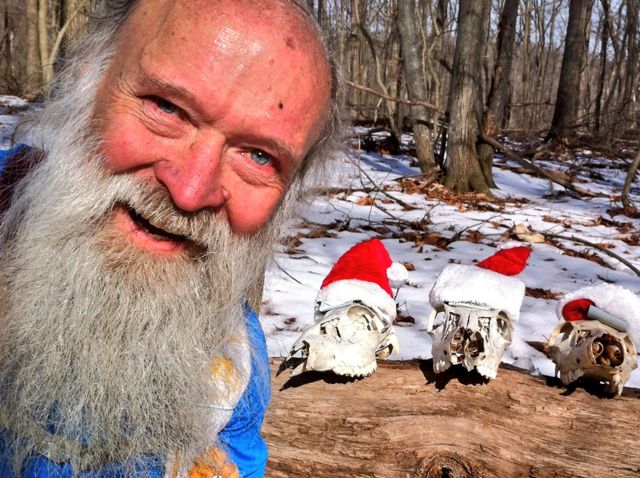 | Snow earlier this week followed by warm days makes for an über-mudday Seneca Creek Greenway Trail race. Since it's not going to be a fast day, it might as well be fun, eh? At ~8 miles into the trek I spot a trio of deer skulls on a log, each one wearing a Santa Claus style cap. Photo op! After lying down on the ground by the tableau to take a self-portrait another runner comes by. He kindly pauses to take additional pictures of me there. |
| A freight train rumbles across the old stone viaduct above Seneca Creek and provides another selfie opportunity at mile ~16. See the report on the SCGT of 2006 for an image from the same spot taken by dear friend Caren Jew during the race 8 years ago — her first ultramarathon! | 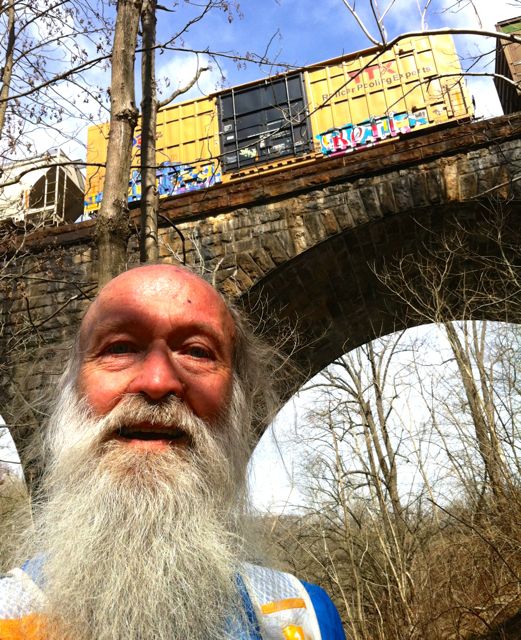 |
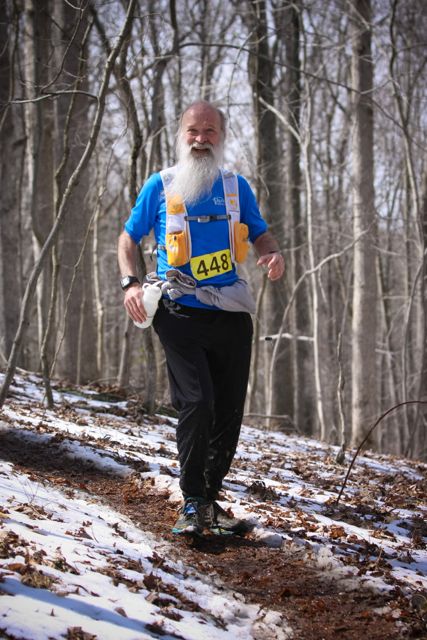 | Ace photographer Ken Trombatore captures the archetypal contrast of today, between happy trots along dry, safe segments of the course, and nervous descents on melted-and-refrozen icy chutes. Conditions overall are tougher than during the "Ice Year", the 2007 SCGT. | 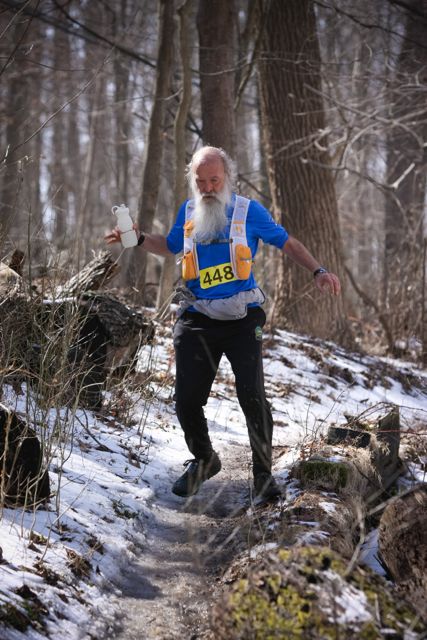 |
| The main reason for difficulty: mud, muck, and mire. A typical view downward at mile 20 shows shoes standing in soul-sucking sole-sucking slime. After walking most of the second half, however, I feel a burst of energy once the course turns onto the final uphill paved pathway. According to the Garmin GPS trackfile that stretch is the fastest of the day. I pass a runner in a Spiderman costume, who after he finishes kneels down in front of a woman, pulls out a ring, and asks her to marry him. She accepts. Barry Smith finishes in 8:19, far ahead of my official result of 8:32:35 gun time, 08:31:51 chip time. Ken Swab reports on his journey with badly injured ultra-tough (and ultra-foolish) Jennifer Weiland on the longer "50k" (likely 32+ miles) run. They arrive in about 9:14. Friends Rebecca Rosenberg and Gayatri Datta wisely declare victory and stop at the MD-355 aid station, 20+ miles in. Adeline Ntam poses for photos with me before and after the race; she does the 50k in under 8 hours. | 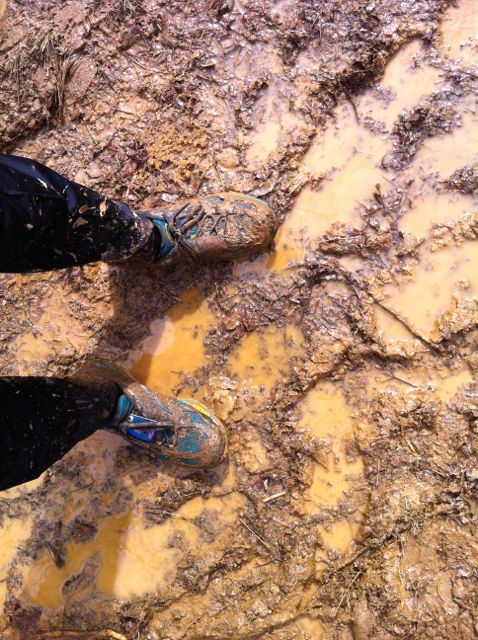 |
- Saturday, April 05, 2014 at 19:44:19 (EDT)
From Chapter 7 of There Are No Secrets by Wolfe Lowenthal, comments about Taiji (T'ai Chi Chuan) and being a guest:
K'e Ch'i means "manners," that characteristic of the Chinese that can be graceful when sincere and annoying when an empty formality. The etymology of the phrase is revealing. "K'e" means "guest." "Ch'i" is the same word — breath, air, spirit force — that is at the center of Tai Chi. So taken together, "K'e Ch'i" is "the air of a guest."
One could hardly have a better guiding principle. We are all guests. That we own and possess the world is the dominant, destructive illusion of "civilized" man.
Think of being a guest of the earth. Grateful, glad to be in this lovely house, respectful of everything which is, after all, not yours; but not subservient either, secure that your presence is welcome and provided for by a beneficent universe.
In doing push hands our attitude should also be K'e Ch'i. We should not try to dominate or overpower the opponent. Professor said that if your idea is to push or not be pushed, it is not Tai Chi.
The correct idea is to let the opponent have his way completely — we should not interfere with his energy. As a matter of fact, we empty out, allowing his force to proceed unobstructed; we even, ever polite, assist in the direction he so eagerly wishes to go. Very self-effacing, very considerate. Like a guest.
If it happens that, as a result of our non-resistance and assistance, an aggressive person finds himself sailing through the air when his intention was to send us flying, we have not violated the principle of K'e Ch'i. Nature asks us only to stay balanced, and that is all we have done when the attacker sails away.
The Tai Chi form also expresses the attitude of K'e Ch'i. Think of our image of arrogance: chest puffed out, body rigid and hard, face frowning. Then think of the Tai Chi posture: body soft, energy dropping into the ground with the chest slightly hollowed, countenance gentle. The very attitude of humility.
Tai Chi proves correct the Biblical statement that "the meek shall inherit." That is an accurate evaluation of the outcome of a contest between arrogance and true humility. The uptight brittleness and floating quality of arrogance is no match for the person who has let go into the earth and can tap its power.
(cf. Gentleness, Sensitivity, Compassion (2014-03-09), Virtues of Softness (2014-03-20), ...)
- Thursday, April 03, 2014 at 04:14:19 (EDT)
Game of Thrones by George R. R. Martin is quite a Phenomenon of our Age. After recently finishing the reading of 5 volumes (and the watching of 3 seasons of the video version), some troublesome trends emerge:
There's also a reduction, though not a disappearance, of beautifully drawn scenery and evocative atmosphere. There's more repetitive prose, including excessive use of catch-phrases (e.g., "much and more", "little and less") and the past perfect tense ("... had done"). The world has only a tiny playlist of popular songs, an even smaller subset of which are repeatedly cited. And there's the prurient focus on women as perverse or evil temptresses, as objects for public exposure and exploitation, and on menstruation as a deeply disturbing phenomenon.
All negative drifts of the narrative flow, disquieting in multiple ways. They add up to a sad feeling of exploitation of the reader/viewer, a manipulation of the addicted fan base by steady ramp-up of violence and nastiness. Ugh.
- Wednesday, April 02, 2014 at 04:40:39 (EDT)
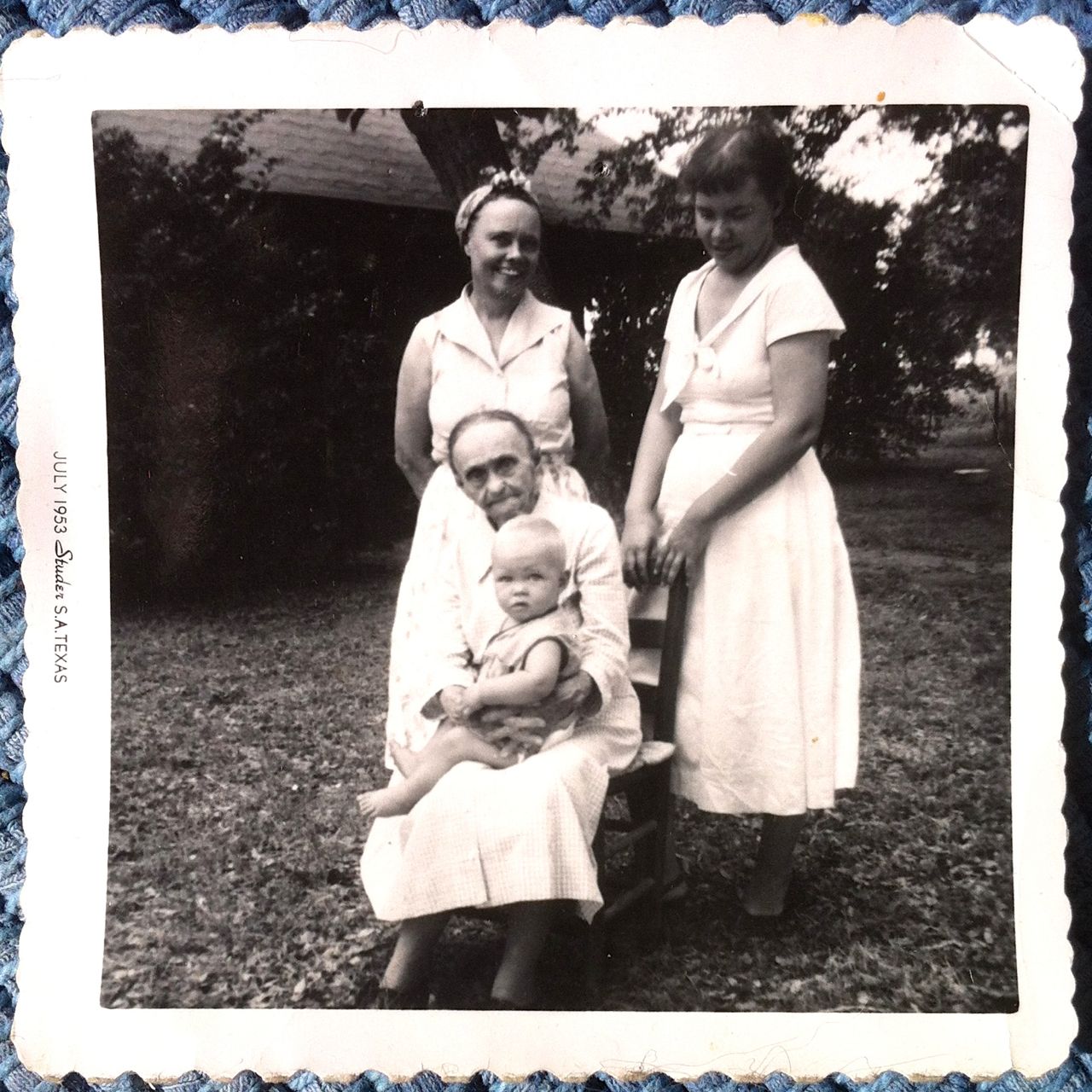
Four generations on my Mom's side: I'm the baby in the lap of great-grandmother Anna T. Frenzel Schroeder (1863-1954), with grandmother Elvira A. Schroeder Meinke (1901-1984) behind, and mother Minnie Merle Meinke Zimmermann (1932-) on the right. Date on the photo of July 1953 is when the film was developed, so since I was born at the end of September 1952, I was less than 11 months old ...
- Monday, March 31, 2014 at 20:20:38 (EDT)
Tricycle magazine recently shared a thoughtful excerpt from Being Zen, a 2002 book by Ezra Bayda, that suggests a checklist of reminders for use "when the clarity of practice becomes obscured by the dark and swirling energy of emotional distress":
Bayda concludes, "We see that our emotional drama, however distressful, is still just thoughts, just memories, just sensations. Who we really are—our basic connectedness—is so much bigger than just this body, just this personal drama."
(cf. Karma (2009-07-15), Without Effort, Analysis, or Expectation (2010-08-04), Ceaseless Society (2012-05-10), Do Your Usual Practice (2013-09-15), 01 (2013-11-05), ...)
- Wednesday, March 26, 2014 at 04:41:02 (EDT)
In the HBO series Game of Thrones (Season 3, episode 3), a lovely observation by one of the characters ("Blackfish"):
| "It often comforts me to think that, even in war's darkest days, in most places in the world, absolutely nothing is happening." |
(cf. No Beginning, No End (2013-03-24), ...)
- Tuesday, March 25, 2014 at 04:06:04 (EDT)
Mnemonics are great tools to focus the mind on important fundamentals. In T'ai Chi Chuan (Taiji) a good set of "Five Basic Principles" can be represented, some say, with the acronym BURST:
That source's list includes a supplemental second set of concepts: Softness (Yielding), Momentum, Continuity, Breathing, Rooting, and "Swimming in Air". A slightly modified, and far more memorable, acronym thus suggests itself:
... the first letters of which spell ... <<blushes>> ...
(see [1] and [2] for other explanations of the same set of basic principles; cf. Come SAIL Away (2011-11-26), ...)
- Monday, March 24, 2014 at 04:45:37 (EDT)
Sandbagger Mary Ewell isn't sure she can go the distance, but then on the way back insists on doing extra laps around the track to make sure we exceed 10k, as we run and walk along Sligo Creek Trail from near the Beltway downstream to Adventist Hospital and back, pursuing splendid conversation, observing lovely dogs, and marveling at beautiful-loud chimes from the playground. Friend Kathy B from an office where I worked years ago says "Hi!" and startles me. Runtastic and Garmin GPS record details.
- Friday, March 21, 2014 at 04:14:14 (EDT)
In Chapter 11 of There Are No Secrets by Wolfe Lowenthal, more thoughts on softness:
A good standard for a Tai Chi school is how involved women students are with push hands. Push hands is about using softness rather than strength; it is ideally suited to women. But in many schools, push hands classes consist of a gang of strong men blocking and shoving each other around while most of the women sit on the sidelines.
To be able to win with Tai Chi principles requires a great deal of time and effort. In the meantime, without proper guidance, a class commonly descends to its lowest common denominator, the domination of strength and aggression over softness and sensitivity.
Here is where many women find difficulty. Professor Chen said that women are naturally much more gifted in Tai Chi. Their understanding of sensitivity and softness usually takes men years to achieve. However, it can take a decade for their talent to "pay off." In the meantime, in an insensitive push hands environment, they will be shoved around and, probably most frustrating of all, be "taught" by stronger men who assume that because they are winning, they must know more.
Applying the virtues of softness is frustrating and difficult. All sincere push hands students — men and women — must confront this problem.
(cf. AikidoSpirit (2003-12-09), Opening to Love (2013-09-27), Ground of Being (2013-10-03), ...)
- Thursday, March 20, 2014 at 04:23:13 (EDT)
Temps are in the 20's for a Difficult Run run along trails at Great Falls National Park, with Gayatri Datta, Rebecca Rosenberg, Barry Smith, and Ken Swab, after Barry and I try the Potomac Heritage Trail and find it ice-covered and dangerous at the American Legion Bridge (upstream) end (cf. 2014-03-01 - Icy Potomac Heritage Trail with Barry). A trip-and-fall on some sticks in first quarter mile bruises hands and scrapes legs, and the old hamstring is still achy. So at mile 6, when Gayatri and I are far behind the rest, we take the Carriage Road shortcut back and then run upstream and back until the rest of the gang arrive. Runtastic and Garmin GPS record details of route and pace and elevation.
- Wednesday, March 19, 2014 at 04:12:49 (EDT)
A neat new-to-me word: kleos, explained by Rebecca Newberger Goldstein in "What Would Plato Tweet?" as:
...The word comes from the old Homeric word for "I hear," and it meant a kind of auditory renown. Vulgarly speaking, it was fame. But it also could mean the glorious deed that merited the fame, as well as the poem that sang of the deed and so produced the fame. The medium, the message, and the impact: all merged into one shining concept.
Kleos lay very near the core of the Greek value system. Their value system was at least partly motivated, as perhaps all value systems are partly motivated, by the human need to feel as if our lives matter. A little perspective, which the Greeks certainly had, reveals what brief and feeble things our lives are. As the old Jewish joke has it, the food here is terrible — and such small portions! What can we do to give our lives a moreness that will help withstand the eons of time that will soon cover us over, blotting out the fact that we ever existed at all? Really, why did we bother to show up for our existence in the first place? The Greek speakers were as obsessed with this question as we are.
Or, as per the current Wikipedia definition-article:
Kleos (Greek: κλέος) is the Greek word often translated to "renown", or "glory". It is related to the word "to hear" and carries the implied meaning of "what others hear about you". A Greek hero earns kleos through accomplishing great deeds, often through his own death.
Goldstein likens it to the "Klout" score of social-media impact; perhaps it's also akin to a chess rating, or a runner's PR (Personal Record, aka PB = Personal Best), or some similar semi-quantitative measure of noteworthy ability.
And in the best case, maybe it can become a benchmark to calibrate oneself against, on the way to self-actualization?
- Tuesday, March 18, 2014 at 04:28:50 (EDT)
Barry Smith and I arrive early for a planned group trek today with comrades, to scout out the Potomac Heritage Trail. But we discover the gate closed to Turkey Run Park. Fallback: the Live Oak Dr trailhead for the PHT, just outside the Capital Beltway. Plenty of parking there, but the trail so icy that it's essentially unrunnable. After a quarter mile of cautious walking and only a few steps of running, we turn back. Under the American Legion Bridge pause for photos of graffiti. Garmin GPS and Runtastic on the iPhone show the route.
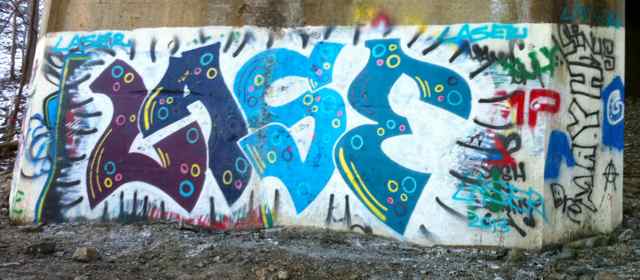
| 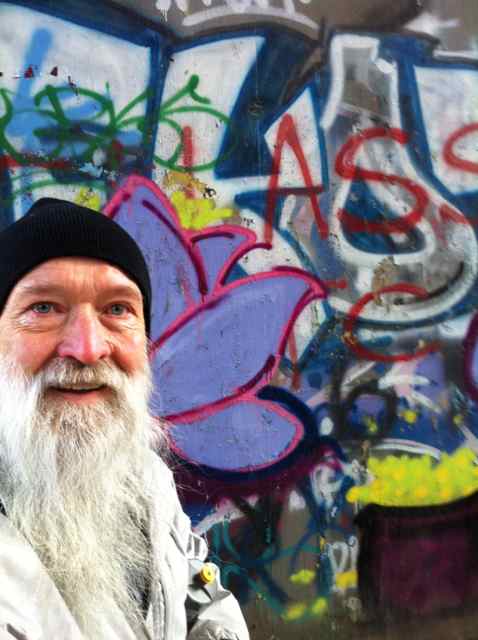 |
- Monday, March 17, 2014 at 04:05:13 (EDT)
At the local Taco Bell my eldest son is explaining "Twitch Plays Pokemon" to me. A random passer-by pauses and says, "I don't want to seem like I'm eavesdropping, but ..." and lurches into a detailed commentary on recent events in the virtual world.
As its creators describe it, Twitch Plays Pokémon is "... a stream that lets you play Pokémon with a lot of other people by typing commands into chat." It was developed and launched a little over a month ago, soon picked up many thousands of participants (and even more lurkers), and developed into a fascinating time-sink as sub-populations fought to control the little video-game character and make progress in the game. Majority-rule and friendly collaboration managed to overcome random-walk and the forces of chaos that were deliberately trying to hinder the mission. (And it even made XKCD!)
Most of all, the emergent fad reminded me of phenomena mentioned in All Your Base Are Belong to Us, and in Extraordinary Popular Delusions and the Madness of Crowds (1841, Charles Mackay). And there's the accelerating pace of change alluded to by Vernor Vinge (Marooned in Realtime, where people who are even slightly out-of-the-loop can't quite understand what is going on in the rest of popular culture:
" ... In 2207 we were the hottest project at Stellation Inc. They put everything they had into renting those easements around the sun. But after 2209 the edge was gone from their excitement. At the marketing conference at Luna, it almost seemed Stellation's backers were trying to sell our project as a frivolity."
And yet, in a few more months, will "Twitch Plays Pokémon" be forgotten as the newest new thing takes over mindshare? Maybe that's another reason to read and study and learn stuff "with legs" that will still be valid in the long term, centuries from now — calculus, history, entropy, Shakespeare, ....
(cf. LearningInvestment (2000-02-11), DeliberateOpinion (2001-10-14), HelpfulHomilies (2007-09-02), ...)
- Sunday, March 16, 2014 at 05:30:53 (EDT)
A favorite quote from the film Iron Man, where at one point a villain is complaining that the people working for him to build a super-power-supply aren't able to reproduce what the hero did:
| "Tony Stark was able to build this in a cave! With a box of scraps!" |
- Friday, March 14, 2014 at 04:13:08 (EDT)
 | Meetings during a quick business trip finish in late afternoon, so instead of taking another 10-mile $40 taxi ride back to the hotel near LAX, there's time to take in the sights along the Los Angeles beaches, from Santa Monica pier to Marina del Rey, past the Venice "boardwalk" of tattoo parlors, artists, psychics, and shops where for $40 one can get an instant diagnosis of one's need for medical marijuana. |
| An atomic-bomb-cloud-shaped sculpture titled "Chain Reaction", made of heavy chain links, is starting to fall apart and has been fenced off, with signs that say "DANGER". Nukes are risky in art as well as in real life! A Los Angeles TIMES story appears the the next day, "Santa Monica City Council votes to save 'Chain Reaction' sculpture". | 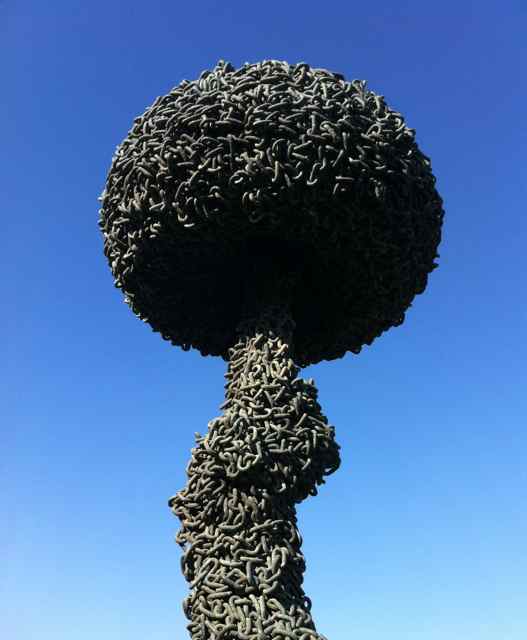 |
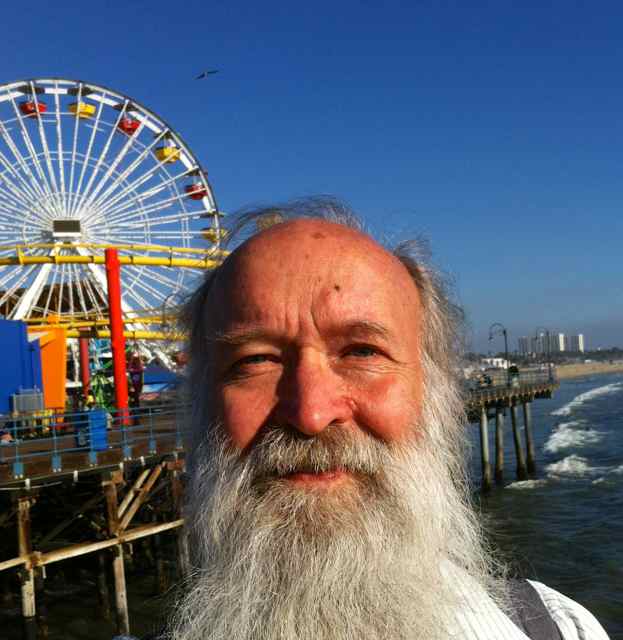 | Runtastic maps the route. The iPhone GPS trackfile includes a long pause in a head shop where I buy just-in-time-manufactured Hello Kitty t-shirts for DW, plus breaks to take photos of self and other tourists on piers. |
- Thursday, March 13, 2014 at 04:14:25 (EDT)
Recently a friend shared last year's essay "22 Habits of Unhappy People" by Ryan McKenzie. It expands upon the author's thesis that "Happiness is something that happens through a series of experiences, habits and realizations over the course of your life." Yes, the language is often ungrammatical, the style is awkward, and the list is somewhat repetitive. The author's psychology of happiness is debateable.
But put aside those weaknesses; the ideas are still good. McKenzie's list of things to avoid, with excerpts from his explanations:
(cf. Optimist Creed (1999-04-16), Unenviable Happiness (2006-02-27), Asimov on Happiness (2007-11-07), Pursuit of Happiness (2008-11-19), Habitual Virtue (2008-12-18), Personal, Permanent, Pervasive (2009-04-27), Trusting and Happy (2010-06-10), When Someone You Love Is Unhappy (2011-05-29), Models of Happiness (2012-01-05), Just One Thing (2012-12-02), Smile at Everyone (2013-02-15), Expectations vs. Possibilities (2013-08-13), Thirty Things (2013-10-01), Happiness Buffer (2013-12-22), ...)
- Tuesday, March 11, 2014 at 05:38:10 (EDT)
| Important Tip: when refilling bottle in fancy restroom, hold under water tap, not under automatic soap dispenser! Today's trek with Amy Couch and Gayatri Datta starts at Amy's front door and proceeds along the Anacostia Tributary trail system: down Sligo Creek and Northwest Branch, up Northeast Branch and Paint Branch, and across the University of Maryland campus to close the loop. We see dozens of geese and robins and ducks, one huge turkey vulture, and one deer. After 20 miles, Gayatri confesses that she did 6 miles on Friday and 16 on Saturday. So, for some obscure reason, she feels a wee bit tired — hmmmmm! Gayatri and I send Amy, who still feels frisky, ahead via Sligo Creek during the final miles back to her home. We take a short-cut along Dale Dr to arrive a few minutes behind her. As it has been for weeks, my left hamstring (gluteus maximus? piriformis? ITB?) is achy but tolerable. As happened a fortnight ago, Amy gets a couple of bonus miles compared to what her marathon training schedule prescribes — yay! Runtastic and Garmin provide details of the route and pace, including a long pause at UM to find an unlocked building, visit the facilities, and rinse out a soapy water bottle.
| 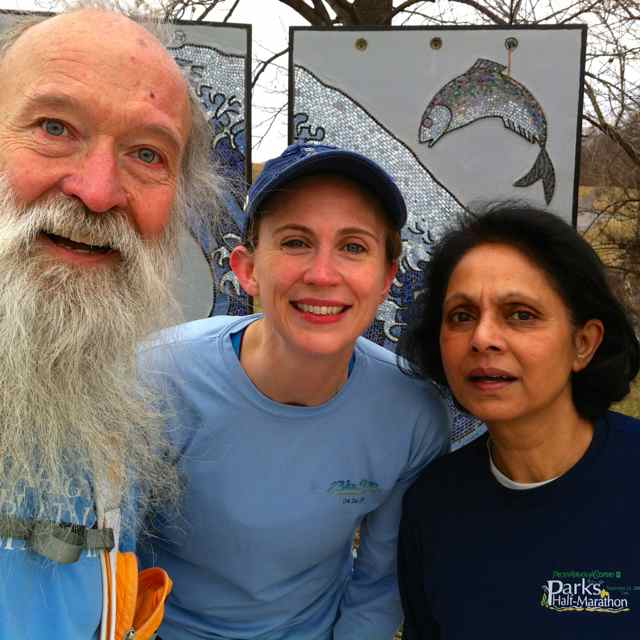 |
- Monday, March 10, 2014 at 04:40:54 (EDT)
From Chapter 10 of There Are No Secrets by Wolfe Lowenthal, a reminder to soften:
Many students resist the notion that it is possible to be soft in the face of a violent attack. Perhaps it is that most of us feel so powerless in society; we carry such residue of frustration and anger. Whatever the cause, a prevalent image is that of the violent attacker who deserves death or worse at our hands, whether or not we're capable of delivering it.
"Fearlessness in the face of ferocity" also requires the old Confucian virtue: "Do not do to another what you would not have him do to you." Confronted by an attacker, our tendency is to depersonalize and objectify. The attacker as monster. Not a fellow human being, full of fear and pain. We cannot see the small, hurt child beneath the raging image of the mugger — and who knows what subconscious parental images are being triggered at the same moment? These images produce tension, anger and fear, none of which are of any value in an appropriate martial response.
One of the principles of the Tao is that the world reflects what we hold in our hearts. An angry person will live in a hostile, anger-provoking world, while a loving person will have a much different experience of the very same environment.
It is true that there are few capable of mastering their fear to the extent that they can respond softly to a violent attack. But it is both the paradox and glory of Tai Chi Chuan that the very virtues which many understand to be the secret of living — gentleness, sensitivity, compassion — are as well the secret of mastery of the martial art.
"So far to go," sighs the student.
Echoing the "... simple, soft power of Aikido ...".
- Sunday, March 09, 2014 at 11:28:21 (EDT)
After the latest snow it's an icy shoulders-of-the-roads Sunday afternoon jog to Ken Swab's home, where Don Libes joins us for a meander around the north Bethesda neighborhood, pulling me along for 5 miles with hilarious banter. Then the achy old left hamstring joins the twingy old right knee (banged against the car door last night, ouch!), and mutually persuade me to wimp out and take the J2 Metrobus most of the way back home, after Ken kindly shows me a shortcut to the nearest stop. At that point, however, OCD kicks in and makes me add a few final blocks to ensure all GPS readouts exceed 12 miles. Runtastic and Garmin GPS concur in the foolishness.
- Saturday, March 08, 2014 at 04:28:14 (EST)
A comrade suggests gently that one shouldn't say "I'm sorry!" when a situation is not one's fault, when only trying to express regret for what's happening and sympathy for what others are experiencing. Sometimes instead of an apology, "I'm sorry!" can be a poke, a sarcastic weapon. Too often it's over-used. When running with friends, at times we've allocated each person a quota of one "Sorry!" per mile. Maybe a similar limit in regular conversation is appropriate too?
(for examples of the "1 sorry/mile" quota see 2009-01-18 - Goose Creek and the WOD, 2009-05-30 - CM is a Wimp, 2010-01-16 - Shooting Starr on Sligo Creek, ...)
- Friday, March 07, 2014 at 04:33:50 (EST)
Slouching to Bethesda on Saturday morning for a meet-up; rainbow oil slicks show the safer spots between icy patches on the pavement as chilly drizzle shifts to sleet and then eye-stinging snow showers. Gayatri Datta jogs with me for the middle ~5 miles as Barry Smith, Don Libes, Ken Swab, and Rebecca Rosenberg trek ahead on Leland St and Beach Dr into DC. A peloton of salt trucks lines up in preparation for duty. On Brookville Rd at the party store parking lot, a prize lies in a puddle: a pair of soggy houndstooth gloves. Runtastic and Garmin GPS concur on course and pace.
- Thursday, March 06, 2014 at 04:12:19 (EST)
A psychological phenomenon mentioned in Chapter X of Benjamin Franklin's Autobiography (but which I somehow overlooked among Franklin on Dogmatism, Franklin on Libraries, Franklin on Pride, Franklin on Vegetarianism, Franklin's Virtues, etc.): the long-term benefits of learning to graciously receive favors. Wikipedia's article on the "Ben Franklin Effect" leads to the relevant passage, wherein Franklin tells how he befriended a one-time rival in the legislature where he was a clerk:
I therefore did not like the opposition of this new member, who was a gentleman of fortune and education, with talents that were likely to give him, in time, great influence in the House, which, indeed, afterwards happened. I did not, however, aim at gaining his favour by paying any servile respect to him, but, after some time, took this other method. Having heard that he had in his library a certain very scarce and curious book, I wrote a note to him, expressing my desire of perusing that book, and requesting he would do me the favour of lending it to me for a few days. He sent it immediately, and I return'd it in about a week with another note, expressing strongly my sense of the favour. When we next met in the House, he spoke to me (which he had never done before), and with great civility; and he ever after manifested a readiness to serve me on all occasions, so that we became great friends, and our friendship continued to his death. This is another instance of the truth of an old maxim I had learned, which says, "He that has once done you a kindness will be more ready to do you another, than he whom you yourself have obliged." And it shows how much more profitable it is prudently to remove, than to resent, return, and continue inimical proceedings.
Shades of David Singer's advice to "Let others be generous", as well as the "No enemies!" rule ...
- Wednesday, March 05, 2014 at 04:41:48 (EST)
| As snow and sleet sting the eyes it's a ladder of laps, 1-2-3-4-3-2-1, in the near-darkness at 7pm around the Bowie High School track. The left hamstring (or is it the glute?) aches, as it has for some weeks now. Runtastic shows one view of the course and pace, based on the iPhone's GPS. | 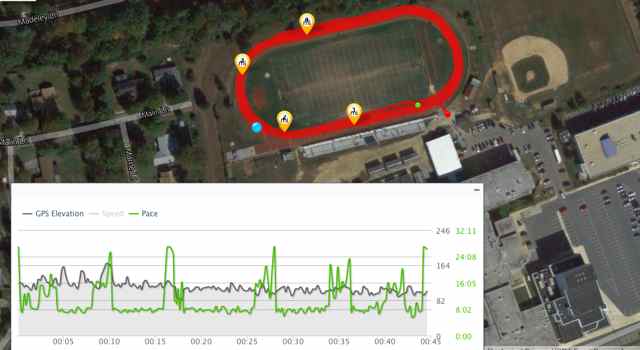 |
 | The Garmin wrist GPS provides a sharper graph of pace versus time, with an inverted axis. Splits: 2:14 + 3:53 + 5:50 + 7:52 + 6:00 + 3:52 + 1:57 |
- Tuesday, March 04, 2014 at 04:14:42 (EST)
A philosopher-comrade (GdM) recently pointed out Massimo Pigliucci's essay "Is Information Physical? What Does That Mean?". It discusses "... a problem that has much to do with philosophical theories of truth and with the difference between physics and metaphysics".
Well, maybe not. The "problem" under discussion revolves around black-hole event horizons, quantum mechanics, and information theory — all of which are then merrily extrapolated many many orders of magnitude beyond any realms in which they have been tested and verified by observation. Isn't it likely that new physics occurs somewhere in that gap between the known world and the event horizon of a hypothetical tiny collapsed object? Isn't it hubris to imagine that today's rules for computing physical events all apply unchanged in such circumstances?
A metaphorically-rich paragraph of Pigliucci's article observes:
Susskind boldly proposed that the universe itself behaves as a hologram, i.e., that all the information that constitutes our three-dimensional world is actually encoded on the universe's equivalent of a black hole's event horizon (the so-called cosmic horizon). If true, this would mean that "reality" as we understand it is an illusion, with the action actually going on at the cosmic horizon. Baggott ingeniously compares this to a sort of reverse Plato's cave: it isn't the three-dimensional world that is reflected in a pale way on the walls of a cave were people are chained and can only see shadows of the real thing; it is the three-dimensional world that is a (holographic) projection of the information stored at the cosmic horizon. Is your mind spinning properly? Good.
A lovely image — but no exotic physics is needed to raise the same philosophical issues. Look at the situation in complex analysis, where Cauchy's integral formula says that the value of a smooth-enough function is determined by its values on the boundary of a region. Or similarly, consider how a wave equation everywhere inside a volume can be solved by Green's function methods if initial values and boundary conditions are known. No deep magic there.
And in fact, after discussing alternative theories of "truth", philosopher Pigliucci eventually concludes his essay similarly. Far-out science is rather irrelevant, except perhaps as a metaphor. And metaphors aren't "truth"!
(cf. PhysicsEnvy (2001-04-11), ... )
- Monday, March 03, 2014 at 17:43:25 (EST)
New-to-me word, used in a message from a friend: bricolage — from the French for "tinkering", artwork made out of a jumble of available stuff ... kinda like improv, eh?!
- Sunday, March 02, 2014 at 10:20:41 (EST)
| Color-coordinated back-to-back 20 milers! Today brings a Sunday stroll with Amy Couch and Stephanie Fonda along the Metropolitan Branch Trail, from Amy's 'hood to Union Station, where I buy cups of coffee for everyone. After a pause to visit the loo we head back. It's neat urban sightseeing, superb conversation, and nobody falls down. As usual, I underestimate the distance, and we overshoot the 18 mile goal on Amy's training plan. Stephanie and I add a little loop at the end to reach round numbers on all GPS systems we carry. Topics of discussion include analyses of ladies' sports garments, the value of a semester devoted to reading a 15-page dialogue of Plato in the original Greek, hair colors, ketosis, what's lost when college becomes vocational training, how to pronounce "cement" (CEE-ment) and "umbrella" (UMBER-ella) when speaking to family over the phone (Amy is from Arkansas), polarized training, and much much more. | 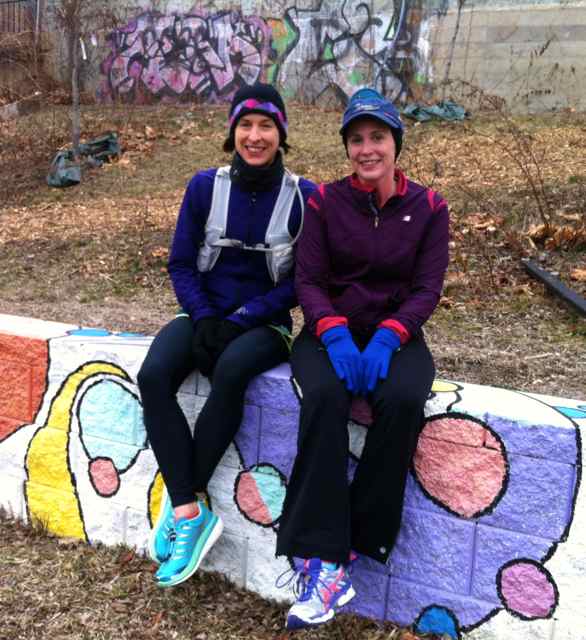 |
- Thursday, February 27, 2014 at 04:32:42 (EST)
Gayatri Datta stumbles and falls at 9:30am on Rock Creek Trail while running with me; Barry Smith does likewise at 10:30am. I head for home immediately, before my turn comes! Rebecca Rosenberg and Sara Crum are far ahead and, cross fingers, avoid a fall. Runtastic and Garmin trackfiles show the rambling route.
- Thursday, February 27, 2014 at 04:19:21 (EST)
"The book is charming in its artlessness." When the Preface by the author's friend says that, you know that you're about to see a work of love, possibly thoughtful but likely amateurish. Wolfe Lowenthal's There Are No Secrets: Professor Cheng Man-ch'ing and his Tai Chi Chuan fits that description. It's a chaotic biography, published in 1991, of a man who came to the USA in 1964 from Taiwan, prescribed Chinese medicine, did calligraphy, founded a T'ai Chi school, and taught for a decade before his death. Wikipedia's article on Cheng provides additional detail.
So ignore the "welter of words and seemingly unstructured paragraphs and chapters", another remark in the Preface by Robert W. Smith. Set aside the author's digressions into his own addictions and issues. Amongst the weeds and clinkers, There Are No Secrets offers shiny nuggets and rough gems. Chapter 32, for instance, begins with the words "The study of Tai Chi is a commitment to being present..." and ends with a quote from Cheng: "Softness is the gung fu of life, hardness is the gung fu of death." In the midst of Chapter 31's discussion of Cheng-recommended massage techniques appears, "The secret is having faith, giving up the feeling that we need to use force to make things happen, and relaxing." And from the conclusion of Chapter 26:
Students becoming serious about Tai Chi practice notice its positive effect on their personality. Relaxation makes one less fearful, less prideful, more open to people and situations.
The cumulative effect of the "integrity" of the practice — integrity in the sense of "wholeness" — has the effect of moderating behavior, making one less prone to fly off the handle or go off the deep end. Integrity develops an individual's sense of responsibility, lessing the negative tendency to place blame on situations or other people.
Sounds like an antidote to the Fundamental Attribution Error. Further quotes and notes from There Are No Secrets to follow ...
(cf. Embrace Tiger, Return to Mountain (2014-01-18), ...)
- Wednesday, February 26, 2014 at 04:50:56 (EST)
The University of Maryland track for some strange reason is completely empty tonight, except for an old coot doing half a dozen 800 meter repeats under a first-quarter moon with temps in the upper 30s and gusty west winds. Icy puddles in lanes 1 and 2 at the north end make for wide turns, after near-slips the first few encounters. Splits are 4:19 + 4:02 + 4:01 + 3:58 + 3:56 + 3:51 with an achy left hamstring/glute. Runtastic and Garmin log the session.
- Tuesday, February 25, 2014 at 10:20:53 (EST)
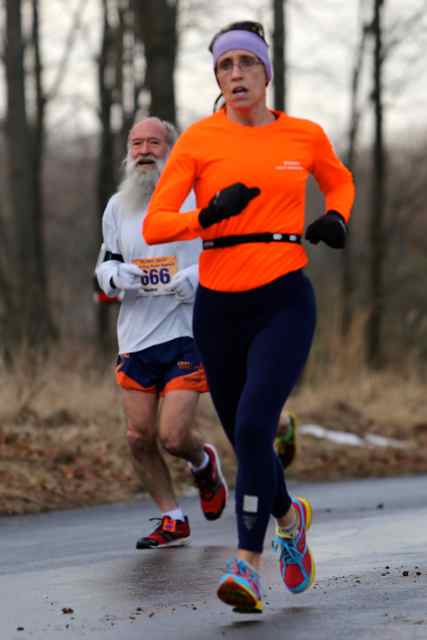 | Jog from home to Barry Smith's (Runtastic/Garmin GPS) where Ken Swab kindly drives us out to Olney for the MCRRC "Country Road Run". The course seems familiar, though the logbook says it's been half a dozen years since the last encounter (cf. 2006-02-05 - Country Road Run, 2007-02-04 - Country Road Run 2007, 2008-02-03 - Country Road Run, Country Road Run). One day after a slow 21 mile trek things turn our well: official time 38:55, about 30 seconds behind arch-rival 7-year-old Jason Parks, 106th place overall, 88th of 189 men, 5th of 18 in the 60-64 year male cohort. Mile splits by the Garmin GPS are 7:34 + 8:00 + 7:53 + 7:33 + 7:45, not too horrible pacing given somewhat hilly terrain. Runtastic and Garmin record the route. | 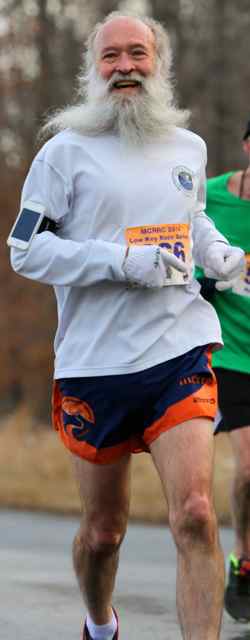 |
- Saturday, February 22, 2014 at 11:45:33 (EST)
At dawn Venus gleams brilliantly as I trot to Bethesda on the icy Capital Crescent Trail. Two fast runners heading east greet me. "Who's that?" I ask, peering in the gloom. Jim Whitnaw and Pete Paulson identify themselves. Gayatri Datta joins me for ~15 miles, and then with Barry Smith, Ken Swab, and Rebecca Rosenberg we do a bit extra. A passing cyclist on Beach Dr drops her water bottle at least four times, and each time that she stops ahead of us I pick it up and return it to her. On the way home I teach Barry the "Doomsday Rule" for mental Perpetual Calendar calculation. Runtastic and Garmin provide GPS data.
- Friday, February 21, 2014 at 04:25:05 (EST)
The upper-20s (°F) feel balmy-warm after a week of Arctic chills, as comrade Kristin Heckman and I do a Pimmit Hills loop pre-dawn. My monologue includes metacognition and the MIT freshman computer science textbook Structure and Interpretation of Computer Programs, with digressions re friends, family, etc. Kristin is amused. Runtastic and Garmin show pace and route.
- Friday, February 21, 2014 at 04:16:14 (EST)
"PnE" — meaning "Possibilities, not Expectations" — is a made-up text-message code that some friends-in-mindfulness and I have been using lately. It's meant to remind ourselves to stay open to possibilities as they unfold, rather than cling to expectations of how the future will turn out. Recently a colleague forwarded a link to James Clear's essay "Forget Setting Goals. Focus on This Instead." (originally at [1]) that makes the same point. The author suggests that what really matters is building better systems, not concentrating on the target end-state. It's journey, not destination.
Clear contends:
What he suggests is rather to design and implement processes — like a Practice, as mindfulness-meditation folks often say. As Clear puts it most nicely:
| "When you focus on the practice instead of the performance, you can enjoy the present moment and improve at the same time." |
Yes — and when the goal goes away, maybe "improve" takes on a new meaning itself!
(cf. Present-Moment Reality (2008-11-05), Expectations vs. Possibilities (2013-08-13), ...)
- Thursday, February 20, 2014 at 04:44:56 (EST)
It's a delightful winter morning for a ramble, with temps in the 20's. Like yesterday, we mainly follow ice-free Beach Dr, down Rock Creek into DC. Barry Smith and Don Libes (newly clean-shaven, but concealing his chin behind a balaclava) have time constraints and must turn back early. Amy Couch and Stephanie Fonda and I continue to Broad Branch Rd. The Candy Cane City parking lot is full of training group cars. I offer Stephanie my windbreaker-mitten-shells to help her cold hands, and she says they're small. I feign insult, with "You know what they say about men who wear small mittens?" Stephanie banters back.
Superb conversation along the way ensues, with discussions of training, diet, self-awareness, injuries, and families. Amy is ramping up for a comeback marathon in April at Gettysburg. Stephanie is doing high mileage at a measured pace with intermittent fasting to promote ketosis. It's a thoughtful, fun sharing of ideas and experiences. The song "Tonight, Tonight" is playing on Stephanie's car radio as she prepares to give me a ride home. Runtastic and Garmin generally agree.
- Wednesday, February 19, 2014 at 04:13:55 (EST)
Today's chilly run features winds that make it seem even colder. Temps are in the 20s and there's ice on the sidewalks. After one solo Mormon Temple hill climb I join Barry Smith and Gayatri Datta for 10 down Rock Creek and back. Along the way we meet Loren Alikhan, a young DC lawyer out on a long lone run; her car wouldn't start this morning, and she missed a meeting with her buddy. We accompany her for several miles back to Barry's and Gayatri's cars, and then I escort her back down Jones Mill Rd to East-West Hwy, from which she knows the way home. Runtastic concurs generally with the Garmin GPS.
- Wednesday, February 19, 2014 at 04:07:34 (EST)
For back issues of the ^zhurnal see Volumes v.01 (April-May 1999), v.02 (May-July 1999), v.03 (July-September 1999), v.04 (September-November 1999), v.05 (November 1999 - January 2000), v.06 (January-March 2000), v.07 (March-May 2000), v.08 (May-June 2000), v.09 (June-July 2000), v.10 (August-October 2000), v.11 (October-December 2000), v.12 (December 2000 - February 2001), v.13 (February-April 2001), v.14 (April-June 2001), 0.15 (June-August 2001), 0.16 (August-September 2001), 0.17 (September-November 2001), 0.18 (November-December 2001), 0.19 (December 2001 - February 2002), 0.20 (February-April 2002), 0.21 (April-May 2002), 0.22 (May-July 2002), 0.23 (July-September 2002), 0.24 (September-October 2002), 0.25 (October-November 2002), 0.26 (November 2002 - January 2003), 0.27 (January-February 2003), 0.28 (February-April 2003), 0.29 (April-June 2003), 0.30 (June-July 2003), 0.31 (July-September 2003), 0.32 (September-October 2003), 0.33 (October-November 2003), 0.34 (November 2003 - January 2004), 0.35 (January-February 2004), 0.36 (February-March 2004), 0.37 (March-April 2004), 0.38 (April-June 2004), 0.39 (June-July 2004), 0.40 (July-August 2004), 0.41 (August-September 2004), 0.42 (September-November 2004), 0.43 (November-December 2004), 0.44 (December 2004 - February 2005), 0.45 (February-March 2005), 0.46 (March-May 2005), 0.47 (May-June 2005), 0.48 (June-August 2005), 0.49 (August-September 2005), 0.50 (September-November 2005), 0.51 (November 2005 - January 2006), 0.52 (January-February 2006), 0.53 (February-April 2006), 0.54 (April-June 2006), 0.55 (June-July 2006), 0.56 (July-September 2006), 0.57 (September-November 2006), 0.58 (November-December 2006), 0.59 (December 2006 - February 2007), 0.60 (February-May 2007), 0.61 (April-May 2007), 0.62 (May-July 2007), 0.63 (July-September 2007), 0.64 (September-November 2007), 0.65 (November 2007 - January 2008), 0.66 (January-March 2008), 0.67 (March-April 2008), 0.68 (April-June 2008), 0.69 (July-August 2008), 0.70 (August-September 2008), 0.71 (September-October 2008), 0.72 (October-November 2008), 0.73 (November 2008 - January 2009), 0.74 (January-February 2009), 0.75 (February-April 2009), 0.76 (April-June 2009), 0.77 (June-August 2009), 0.78 (August-September 2009), 0.79 (September-November 2009), 0.80 (November-December 2009), 0.81 (December 2009 - February 2010), 0.82 (February-April 2010), 0.83 (April-May 2010), 0.84 (May-July 2010), 0.85 (July-September 2010), 0.86 (September-October 2010), 0.87 (October-December 2010), 0.88 (December 2010 - February 2011), 0.89 (February-April 2011), 0.90 (April-June 2011), 0.91 (June-August 2011), 0.92 (August-October 2011), 0.93 (October-December 2011), 0.94 (December 2011-January 2012), 0.95 (January-March 2012), 0.96 (March-April 2012), 0.97 (April-June 2012), 0.98 (June-September 2012), 0.99 (September-November 2012), 0.9901 (November-December 2012), 0.9902 (December 2012-February 2013), 0.9903 (February-March 2013), 0.9904 (March-May 2013), 0.9905 (May-July 2013), 0.9906 (July-September 2013), 0.9907 (September-October 2013), 0.9908 (October-December 2013), 0.9909 (December 2013-February 2014), 0.9910 (February-May 2014), 0.9911 (May-July 2014), 0.9912 (July-August 2014), 0.9913 (August-October 2014), 0.9914 (November 2014-January 2015), 0.9915 (January-April 2015), 0.9916 (April-July 2015), 0.9917 (July-September 2015), 0.9918 (September-November 2015), 0.9919 (November 2015-January 2016), 0.9920 (January-April 2016), ... Current Volume. Send comments and suggestions to z (at) his.com. Thank you! (Copyright © 1999-2015 by Mark Zimmermann.)